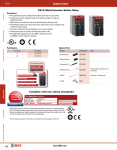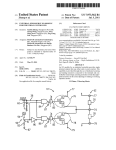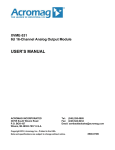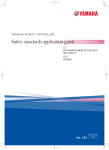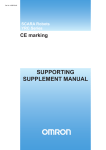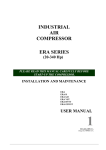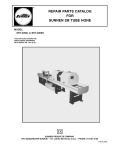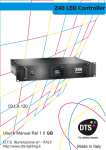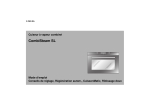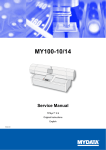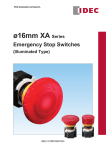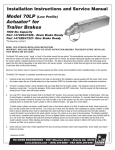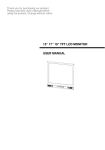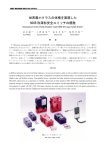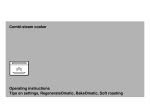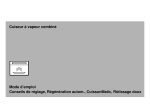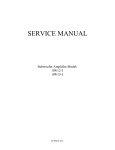Download FS1A Safety Controller
Transcript
FS1A Safety Controller (09/01/07) Complies with key safety standards In Human Machine Interface (HMI) environment, ensuring the safety of operators and machines is given the top priority. Enabling switches, emergency stop switches, light curtains, and other safety products are used to provide safety, and the SafetyOne can monitor and evaluate the safety information from the safety products most effectively. The SafetyOne satisfies the highest requirements of key safety standards, such as category 4 of EN 954-1, SIL3 of IEC 61508, and performance level e of EN ISO 13849-1. The new safety controller of innovative concept helps you implement applications without requiring any programming. All you need is to select one of the eight logic functions; operation starts simply by connecting safety inputs and output equipment. The SafetyOne satisfies: EN954-1: Category 4 IEC 61508: SIL3 ISO 13849-1: Performance level e The SafetyOne complies with: ISO IEC EN ANSI/RIA ANSI SEMI NFPA Reduces overall cost Replaces safety modules—simpler and easier wring One SafetyOne module can replace more than five safety relay modules (when configuring a partial or entire stop—Logic 7), reducing cost, wiring, and checking. When using safety relay modules: When using the SafetyOne: · One SafetyOne · Four safety contactors · Five safety relay modules · Ten safety contactors Replaces programmable safety PLC and safety controller—simpler and easier configuring Safety PLC or Safety Controller Software (programs, function blocks) Logic selection · Safety PLC · Tools required for programming · Creating and debugging a program · Third-party certification for the program (time and cost) 2 · Simple design requiring DIP switch selection only · No tools required · No programming and debugging required · No program certification required (09/01/07) The Next Generation Safety Controller (FS1A) Easy-to-set safety controller requires no programming to configure safety circuits, and meets the highest requirements of key safety standards. Downsizing Monitor Outputs Safety Outputs PLC Monitor Signals Various riouss functions are packed within a compact safety controller. Error Signals 72 mm Replaces more than five safety relay modules 114.5 mm 113.5 mm Muting function of light curtains Light curtain Hazardous Muting sensors Area Solenoid drive output Safety Input Solenoid drive output Work Object Muting lamp Direct connection to various IDEC safety components Emergency Stop Switch XA1E, XW1E, XN1E, HA1B, HA1E, HW1B, HW1E Interlock Switch HS6B, HS5B HS6E, HS5E, HS1E Pilot Light (for muting) Non-contact Interlock Switch HW1P-5Q7 HS7A Enabling/Grip Switch HE1B, HE2B, HE3B, HE5B, HE1G (09/01/07) Interlock Switch with Solenoid Light Curtain (PNP Type) Sensor (for muting) (PNP Type) SA1E SE4B 3 The Next Generation Safety Controller Makes safety circuit configuration easier. IDEC offers Easy circuit configuration by logic selection—no programming Ladder or function block programming is not necessary. World’s first logic-selecting configuration. Eight safety circuit logics are provided. The best solution when the system has multiple points requiring complex I/Os, but the use of programmable controller is not desired. IDEC offers · Programming method has to be learned · Debugging takes time · Application software is needed Emergency Stop Switch The best solution when configuring a system without using a safety relay module, or a safety PLC. A: Entire stop B and C: Partial stop A B A B HS5B A HS5E C C Various safety inputs—mechanical contacts and electric components The SafetyOne can be connected to a variety of inputs such as emergency stop switches and light curtains. Emergency Stop Switch Interlock Switch The best solution to eliminate the use of safety relay modules for each component. Enabling Switch Grip Switch IDEC offers · Reduces setting · Easy checking High performance—partial stop/entire stop No programming required. Partial Stop–Entire stop is achieved by selecting a logic circuit. All you need is to wire the SafetyOne in the same manner as safety relay modules. IDEC offers DIP switch selection Interlock Switch with Solenoid Non-contact Interlock Switch Light Curtain Safety circuit monitoring—circuit diagnosis with monitor outputs Door 1 Door 3 Door 2 Outputs safety I/O status and SafetyOne errors. Safety Outputs The best solution for the control side to monitor which doors are open, and to see the error status of safety circuits. Doors 1, 2, 3 PLC Error signals IDEC offers Easy connection to interlock switches—solenoid drive output (Spring lock type) Solenoid drive output reduces the required I/O points of a PLC. Before After Safety Inputs Safety Inputs The best solution to replace conventional PLCs to control interlock switches. Solenoid Drive Outputs 4 PLC Solenoid Drive Outputs (09/01/07) FS1A SAFETY CONTROLLER Compliant with international safety standards Applicable Standards ISO 13849-1, 10218-1 IEC 61508, 62061, 61496-1, 60204-1, 61131-2, 61000-6-2, 61000-6-4 EN 954-1, 13849-1, 62061, 61496-1, 60204-1, 61131-2, 61000-6-2, 61000-6-4 ANSI/RIA UL R15.06 The SafetyOne satisfies the requirements of SIL3 (IEC 61508), performance level e (ISO 13849-1), and safety category 4 (EN 954-1). 508, CSA C22.2 No. 142 ANSI B11.19 SEMI S2 NFPA 79 Muting function Muting function for a light curtain is provided. Just connect the muting sensor input and the light curtain input to the SafetyOne. Relay box and terminals are not necessary. Muting lamp output can also be connected. Hazardous Area Light Curtain Muting Sensor Light Curtain (PNP type) Make sure that the intersection of optical axes is within the hazardous area. Muting Lamp Work Object Muting Lamp Muting Sensors (PNP type) Note: When installing light curtains and muting sensors, ensure safety by referring to IEC TS 62046 technical documents. Multiple I/Os Connector wiring •14 safety inputs (6 for dual inputs) •4 safety outputs (2 for dual outputs) •2 start inputs •10 monitor outputs •2 solenoid/muting lamp outputs Easy-to-read LED indicators Errors and I/O statuses can be read easily with digital and LED indicators. (09/01/07) Easy connector wiring Can be used with: •Spring clamp connectors •Crimp connectors Off-delay outputs available 8-level selections within 0 to 30 sec. 5 Easy circuit configuration by logic switches A safety circuit for emergency stop switches and interlock switches. Logic 1 General-purpose logic for various apparatus Page 7 A safety circuit for interlock switches, non-contact interlock switches, and emergency stop switches. Logic 2 General-purpose logic for NO/NC contact inputs Page 8 A safety circuit for safety solid state output components such as light curtains, emergency stop switches, interlock switches, and laser scanners. Logic 3 General-purpose logic for apparatus with openings Page 9 A safety circuit for light curtains and muting function. Logic 4 Muting function logic for apparatus with openings Page 10 A safety circuit for two contacts with a long time lag. Logic 5 General-purpose logic for devices for which sync time between contacts cannot be specified Page 11 A safety circuit for mode selection of enabling switches, emergency stop switches, and interlock switches. Logic 6 The logic applicable for selection of active safety input devices Page 12, 13 A safety circuit for partial stop (interlock switches) and entire stop (emergency stop switches). Logic 7 Partial stop 1 logic for various apparatus Page 14, 15 A safety circuit for partial stop (interlock switch A) and entire stop (emergency stop switch or interlock switch B) Logic 8 6 Partial stop 2 logic for various apparatus Page 16 (09/01/07) FS1A Safety Controller Logic 1 Direct Opening General-purpose logic for various apparatus Logic 1 is used for safeguarding measures of machine tools and robots. It can be used with dual direct-opening components such as emergency stop switches and interlock switches. In this logic, when a safety component is operated, the SafetyOne shuts down the safety output immediately. Machine tool Robot During Operation System Stop (safe) The system is equipped with emergency stop switches and interlock switches. The system stops when: • Emergency stop switch is pressed, OR • Guard door is open (interlock switch contacts are open) ⇓ The energized solenoid unlocks the guard door. The system can operate when: • The emergency stop switch is unlatched, AND • Guard door is closed (interlock switch contacts are closed) Emergency Stop Switch Safety Contactor/ Safety Relay ON System runs Press! Safety contactor/ Safety relay OFF System stops OR Open! Interlock Switch Interlock Switch with Solenoid (spring lock type) Solenoid output OFF Guard door locked •Input monitor error detection function All logics have 0.5-sec input monitor error time on the dual channel direct opening inputs. For details, see user’s manual. Solenoid output ON Guard unlocked •Solenoid output function (muting lamp output function) The SafetyOne has a solenoid control output. When operating on Logic 4, solenoid control output functions as a muting lamp output. For details, see user’s manual. Note: Use spring-lock type interlock switch with solenoid. Solenoid lock type cannot be used. (09/01/07) 7 Normally Open and Normally Closed Logic 2 General-purpose logic for NO/NC contact inputs Logic 2 is used for semiconductor manufacturing systems or food packaging systems which have non-contact interlock switches of NO/NC contacts. In this logic, components with dual NO/NC contacts such as a non-contact interlock switch and a mechanical interlock switch, as well as dual direct-opening components such as emergency stop switch and interlock switches can be used at the same time. When a safety component is operated, the SafetyOne shuts down the safety output Semiconductor Manufacturing System Food Packaging System During Operation System Stop (safe) The system is equipped with non-contact interlock switches, emergency stop switches, and an interlock switch. The system stops when: • Emergency stop switch is pressed, OR • Guard door is open The system can operate when: • Emergency stop switch is unlatched, AND • Guard doors are closed Safety contactor/ Safety relay ON Safety contactor/ Safety relay OFF System stops System runs Non-contact Interlock Switches (1NC+1NO) Open! OR Emergency Stop Switch Interlock Switch with Solenoid (spring lock type) Press Press! Solenoid output OFF Guard locked •Monitor output function In addition to safe solid state output, the SafetyOne is equipped with a monitor output which sends internal error information. For details, see user’s manual. Solenoid output ON Interlock Switch with Solenoid Guard unlocked •Auto manual start and control start Each logic has the option of setting one of two start inputs. Choose one that conforms to the system risk assessment. •Auto manual start to detect input level •Control start to detect the input's ON to OFF transition and the time Note 1:Use spring-lock type interlock switch with solenoid. Solenoid-lock type cannot be used. Note 2:For details about non-contact interlock switches, see user’s manual. 8 (09/01/07) FS1A Safety Controller Solid State Logic 3 General-purpose logic for apparatus with openings Logic 3 is a general-purpose logic for robots and conveyor lines which have dual solid state outputs of light curtains and safety laser scanners. In addition, dual direct-opening components such as emergency stop switches and interlock switches can be used at the same time. Light Curtain for High Level of Safety Productivity of conveyor lines and process machines can be improved by installing the light curtains (IEC 61496). Safety can be ensured without the need for installing guard doors. During Operation System Stop (safe) The system stops when: • Light curtain beam is interrupted, OR • Guard door is open (interlock switch contacts are open), OR • Emergency stop switch is pressed ⇓ • The energized solenoid unlocks the door The system is equipped with light curtains, interlock switches, and an emergency stop switch. The system can operate when: • Light curtain beams are not interrupted, AND • Guard doors are closed (interlock switch contacts are closed), AND • Emergency stop switch is unlatched Safety contactor/ Safety relay ON Llight Curtains (PNP type) Beams blocked! Safety contactor/ Safety relay OFF System runs System stops Interlock Switches Emergency Stop Switch Interlock Switch with Solenoid (spring lock type) Solenoid output OFF Guard locked Interlock Switch with Solenoid (spring lock type) Solenoid output ON Guard unlocked Note 1:Use spring-lock type interlock switch with solenoid. Solenoid-lock type cannot be used. Note 2:Use light curtain with a PNP output. (09/01/07) 9 Solid State with Muting Logic 4 Muting function logic for apparatus with openings In Logic 4, muting functions are added to the dual solid state output of Logic 3. Dual direct-opening components such as emergency stop switches and interlock switches can be used at the same time. Muting Function Improves Productivity With a muting function, the system stops when detecting a human and temporarily defeats the light curtain while work objects are being supplied. This improves the system’s productivity. Muting functions can be used easily by connecting the light curtain, muting sensor, and muting lamp to the SafetyOne (Note). In muting status, the OFF signals of corresponding safety solid state outputs are defeated. During Operation (normal operation) During Operation (muting) The system is equipped with light curtains, muting sensors, a muting lamp, and emergency stop switches. The system can operate when: • Light curtain beams are not interrupted, AND • Muting sensor beams are not interrupted, AND • Muting lamp is connected, AND • Emergency stop switches are unlatched When muting is activated, the system continues operating even when: • Light curtain beam is interrupted The system stops when: • Emergency stop switch is pressed. Hazardous Area Hazardous Area Light Curtains Muting Sensors Muting sensor beam blocked Light curtain beams blocked Make sure that the intersection of optical axes are in within the hazardous area. Work Object Beams blocked! Muting Lamp Light Curtain (PNP type) Safety contactor/ Safety relay ON Muting Lamp Light Curtain blocked Safety contactor/ Safety relay ON System runs System runs Muting Sensor (PNP type) Light Curtain (PNP type) Muting Sensor (PNP type) Muting lamp ON Muting lamp OFF Emergency Stop Switch Note 1:Use light curtain with a PNP output. Note 2:Use muting sensor with 3-wire PNP output. System Stop (light curtain beam interrupted by other than work object) The system stops when: • Muting sensor does not detect an object, AND • Light curtain beam is interrupted. Hazardous Area Beams blocked! Safety contactor/ Safety relay OFF System stops Light curtain beams blocked Muting lamp OFF Light curtain beams blocked Note: Use light curtains, muting sensors, and muting lamps which meet the safety regulations or safety category of the country or regions where the products are used. Otherwise safety cannot be ensured, resulting in possible danger. 10 (09/01/07) FS1A Safety Controller Dependant Logic 5 General-purpose logic for devices for which sync time between contacts cannot be specified Logic 5 is used for providing safeguarding measures of various systems such as machine tools and robots. Because the input error detection time of dual inputs (dual interlock inputs) are set to ∞ (infinite), this logic can be used even when there is a long time lag between the two inputs. When a safety component is operated, the SafetyOne shuts down the safety output Door immediately. Switch A Machine Tool STOP Closed Open Open Door Switch B Closed Closed Open Logic 1 Contacts ON (door closed) Door Switch A (1 contact) Preset monitor time is measured. Synchronization of two inputs are checked, and input monitor error is detected when time lag exceeds the preset monitor time. Contacts OFF (door open) Contacts ON (door closed) Door Switch B (1 contact) Contacts OFF (door open) Input Monitor Error Detection Time (0.5s) Logic 5 Contacts ON (door closed) Door Switch A (1 contact) Door Switch B (1 contact) Contacts OFF (door open) Contacts ON (door closed) ∞ Because the input monitor error detection time is not preset, normal operation is continued. Safety output is shut down. Contacts OFF (door open) Input Monitor Error Detection Time (∞) Logic 1 is used when the operations of two contacts (such as of emergency stop switch) occur almost at the same or the time lag can be specified. Higher safety is achieved by specifying the input monitor error detection time. Logic 1, however, cannot be used in applications where the time lag cannot be specified, such as when interlock switches are installed on a guard door. Logic 5 has an infinite monitoring time, therefore it can be used regardless of the location of the interlock switch and the speed to open the guard door. System Stop (safe) The system stops when: • Emergency stop switch is pressed, OR • Guard door is open (interlock switch contact open) Press! Safety contactor/ Safety relay OFF System stops OR ⇓ (door unlocked by energized solenoid) Open! Interlock switch with solenoid (spring lock type) Solenoid output ON Guard unlocked Note: Use spring-lock type interlock switch with solenoid. Solenoid-lock type cannot be used. (09/01/07) 11 Logic 6 Mode Selection The logic applicable for selection of active safety input devices Logic 6 is the mode selection logic used in machine tools, semiconductor manufacturing equipment, and other systems where an active safety component is switched depending on the operation mode. Of dual direct-opening input and dual interlock input, an active input can be selected using the mode selection switch. Mode Selection Ensures Safety When the operator works inside a guard door for teaching, checking, and maintenance, an active safety component needs to be switched from interlock component, such as interlock switch installed on the guard door, or an enabling switch of a grip switch and teaching pendant. Enabling Switch Ensures Safety An enabling switch enables the manual operation of machines and robots only when the switch is maintained in the predetermined position (position 2). When the operator either releases (position 1) or holds tightly (position 3) the switch, the circuit is shut down. While an emergency stop switch is used to stop a machine’s operation by the operator’s intention, an enabling switch is used to disable machine operation by the operator’s reaction (releasing or holding tightly) to unexpected machine operation. 12 (09/01/07) FS1A Safety Controller Auto Mode (Operation) During Operation System Stop (safe) Automatic operation: • The operator is outside the hazardous area • Interlock switches are active • Enabling device is inactive • Emergency stop is active The system stops (safety output off) when: • Emergency stop switch is pressed, OR • Interlock switch is operated System stops Press! (the system stops when neither AUTO nor TEACH is selected with the mode selector switch) OR Open! Inactive Auto Mode Inactive Teach Mode Auto Mode Teach Mode Selector Switch Selector Switch Safety contactor/ Safety relay ON System runs Inactive Enabling Switch Safety contactor/ Safety relay OFF System stops Inactive Open! Interlock Switches OR Interlock Switch with Solenoid (spring lock type) Interlock Switch with Solenoid (spring lock type) Solenoid output OFF Guard locked Emergency Stop Switch Solenoid output ON Guard unlocked Press! Teach mode (Maintenance) During Operation System Stop (safe) Manual operation: • The operator is inside the hazardous area for teaching or maintenance • Interlock switches are inactive • Emergency stop is active • Enabling device is active The system stops (safety output off) when: • Emergency stop switch is operated, OR • Enabling switch is in position 1 or 3 (the system stops when neither AUTO nor TEACH is selected with the mode selector switch) System stops Press! OR Position 1 or Position 3 Inactive Inactive Auto Mode Position 2 Teach Mode Selector Switch Enabling Switch Safety contactor/ Safety relay ON System runs Position 2 Interlock Switches Teach Mode Selector Switch Position 1 or Position 3 Safety contactor/ Safety relay OFF System stops Inactive Inactive Interlock Switch with Solenoid (spring lock type) Interlock Switch with Solenoid (spring lock type) Emergency Stop Switch Auto Mode Solenoid output OFF Solenoid output ON Guard locked Guard unlocked Note: Use spring-lock type interlock switch with solenoid. Solenoid-lock type cannot be used. (09/01/07) 13 Logic 7 Partial Stop 1 Partial stop 1 logic for various apparatus Logic 7 is used for partial stop of systems such as machine tools, semiconductor manufacturing equipment, and food packaging machines. Four safety outputs can be controlled in two lines. Partial Stop Improves Productivity Two-line outputs can be controlled separately for partial stop, improving production efficiency greatly compared to entire stop. During Operation The system is equipped with an emergency stop switch and interlock switches. The system is configured so that pressing the emergency stop switch shuts down the entire system, while opening a door (equipped with an interlock switch) shuts down only the corresponding partial system. The other partial system keeps operating. The entire system can operate when: • The emergency stop switch is unlatched, AND • The guards are closed (interlock switch contacts are closed) Emergency Stop Switch Safety contactor/ Safety relay Emergency Stop Switch Safety output A ON System runs Interlock Switch A Hazardous Area A Interlock Switch A Hazardous Area B Interlock Switch B Safety output B ON Interlock Switch A with Solenoid (spring lock type) Interlock Switch B Interlock Switch B with Solenoid (spring lock type) System runs Solenoid output A OFF Guard locked Solenoid output B OFF Guard locked Note: Use spring-lock type interlock switch with solenoid. Solenoid-lock type cannot be used. 14 (09/01/07) FS1A Safety Controller Partial System Stop (Hazardous Area A) Guard door A is open The contacts of interlock switch A open, and safety output A turns off. Emergency Stop Switch Emergency Stop Switch System stops Safety contactor/ Safety relay Interlock Switch A Open! Safety output A OFF System stops Open! Hazardous Area A Interlock Switch A Hazardous Area B Interlock Switch A with Solenoid (spring lock type) Interlock Switch B Safety output B ON System runs Interlock Switch B Solenoid output A ON Interlock Switch B with Solenoid (spring lock type) Solenoid output B OFF Partial System Stop (Hazardous Area B) Guard unlocked Guard locked Guard door B is open The contacts of interlock switch B open, and safety output B turns off. Emergency Stop Switch System stops Emergency Stop Switch Safety contactor/ Safety relay Interlock Switch A Hazardous Area A Hazardous Area B Open! Interlock Switch A Interlock Switch B Safety output A ON Interlock Switch A with Solenoid (spring lock type) System runs Safety output B OFF Interlock Switch B System stops Open! Interlock Switch B with Solenoid (spring lock type) Solenoid output A OFF Guard locked Solenoid output B ON Guard unlocked Entire System Stop (Hazardous Areas A, B) When the emergency stop switch is pressed, the entire system stops. Emergency Stop Switch System stops Emergency stop switch is pressed Press! System stops Safety contactor/ Safety relay Emergency Stop Switch Hazardous Area A Interlock Switch A Hazardous Area B Interlock Switch B System stops Safety output A OFF Interlock Switch A with Solenoid (spring lock type) Safety output B OFF Interlock Switch A Interlock Switch B Interlock Switch B with Solenoid (spring lock type) Solenoid output A ON Guard unlocked Solenoid output B ON Guard unlocked Note: Use spring-lock type interlock switch with solenoid. Solenoid-lock type cannot be used. (09/01/07) 15 Partial Stop 2 Logic 8 Partial stop 2 logic for various apparatus Logic 8 is used for interlocked partial stop of systems such as machine tools, semiconductor manufacturing equipment, and food packaging machines. Four safety outputs can be controlled in two lines. Partial System Stop (Hazardous Area B) Guard door B is open The contacts of interlock switch B open, and safety output B turns off. Emergency Stop Switch System stops Hazardous Area A Hazardous Area B Open! Interlock Switch A Interlock Switch B Emergency Stop Switch Safety contactor/ Safety relay Interlock Switch A Interlock Switch A with Solenoid (spring lock type) Safety output A ON Interlock Switch B Safety output B OFF System runs System stops Open! Interlock Switch B with Solenoid (spring lock type) Solenoid output A OFF Guard locked Solenoid output B ON Guard unlocked Entire System Stop (Hazardous Areas A, B) Emergency stop switch is pressed, or guard door A is open Pressing the emergency stop switch or opening the guard A stops the entire system (hazardous areas A and B). Emergency Stop Switch System stops Press! System stops Emergency Stop Switch Safety contactor/ Safety relay System stops Press! Hazardous Area A Interlock Switch A Open! Hazardous Area B Interlock Switch B Safety output A OFF Interlock Switch A Open! Safety output B OFF Interlock Switch A with Solenoid (spring lock type) Interlock Switch B Interlock Switch B with Solenoid (spring lock type) Solenoid Output A ON Guard unlocked Solenoid Output B ON Guard unlocked Note: Use spring-lock type interlock switch with solenoid. Solenoid-lock type cannot be used. 16 (09/01/07) FS1A Safety Controller No programming required. Configuration completes by turning on a logic switch only. •A safety circuit can be configured easily just by selecting a logic from eight pre-programmed logics. •Partial/entire stop can be achieved just by selecting a logic. •One SafetyOne module can connect with various inputs such as emergency stop switches and light curtains. •The status of safety I/Os and the SafetyOne errors can be monitored. •Solenoid drive output is provided, eliminating the need for PLC. •IEC 61508 integrity level 3, ISO 13849-1 performance level e, and EN954-1 safety category 4 compliant Types Product Ordering Type No. SafetyOne FS1A-C01S •Standard Accessories •Electric Characteristics Input connector (FS9Z-CN01)···················1 pc Output connector (FS9Z-CN02)················1 pc Marked cable tie (FS9Z-MT01)·················3 pcs Setting tool ···············································1 pc Instruction sheet (B-1088, English)···········1 pc Instruction sheet (B-1087, Japanese)·······1 pc Rated Voltage 24V DC Allowable Voltage Range 20.4 to 28.8V DC Maximum Power Consumption 48W (at the rated power voltage, when all I/Os are ON) (incl. output load) Allowable Momentary Power Interruption 10 ms minimum (at the rated power voltage) Response Time ON–OFF:40 ms maximum (Note 1)/ 100 ms maximum (Note 2) OFF–ON:100 ms maximum (Note 3) Start-up Time (Note 4) 6s maximum Dielectric Strength Between live part and FE terminal: 500V AC, 1 minute Between housing and FE terminal: 500V AC, 1 minute Insulation Resistance Between live part and FE terminal: 10 MΩ minimum (500V DC megger) Between housing and FE terminal: 10 MΩ minimum (500V DC megger) • For details, see the user’s manual. Impulse Noise Immunity (noise simulator) Specifications Power terminal: ±1 kV 50ns, 1μs (direct connection) I/O terminal: ±1kV 50ns, 1μs (coupling adapter) Inrush Current 25A maximum Ground Ground resistance of 100Ω or less Effect of Incorrect Wiring Reverse polarity: No operation, no damage Improper voltage:Permanent damage may occur •Optional Parts (sold separately) Product Ordering Type No. Package Quantity For input FS9Z-CN01 1 For output FS9Z-CN02 1 Connecting Tool FS9Z-SD01 1 Marked Cable Tie FS9Z-MT01PN10 10 Connector DIN Rail BAA1000PN10 10 Mounting Clip BNL6PN10 10 Note Used to lock the protection cover of the FS1A. Aluminum, 1m 35mm wide •Operating Environment Safety Circuit Logic selection type Operating Temperature –10 to +55°C (no freezing) Operating Humidity 10 to 95% RH (no condensation) Storage Temperature –40 to +70°C (no freezing) Storage Humidity 10 to 95% RH (no condensation) Pollution Degree 2 (IEC/EN60664-1) Degree of Protection IP20 (IEC/EN60529) Corrosion Immunity Free from corrosive gases Altitude Operation: 0 to 2000m, Transport: 0 to 3000m Vibration Resistance Vibration: 5 to 8.4 Hz, amplitude 3.5 mm 8.4 to 150 Hz Acceleration:9.8 m/s2 (2 hours each on three mutually perpendicular axes) (IEC/EN61131-2) Bump: Acceleration 98 m/s2, 16 ms (1000 times each on three mutually perpendicular axes) (IEC/EN61496-1) Shock Resistance 147 m/s2, 11ms (3 shocks each on three mutually perpendicular axes (IEC/EN 61131-2) Connector Insertion/ Removal Durability 50 times maximum Configuration Switch Durability 100 operations maximum per pole Enter Button Durability 1000 operations maximum Housing Material Modified-polyphenyleneether (m-PPE) Weight (approx.) 330g (09/01/07) Note 1:The time to shut off safety outputs after inputs are turned off or input monitor error is detected (when off-delay timer is set to 0s) Note 2:Time to shut off safety outputs after an error (except input monitor error) or a configuration change of logic or timer is detected (not depending on the off-delay timer value) Note 3:Auto start—Time to turn on safety outputs after safe inputs are turned on Manual start—Time to turn on safety outputs after start inputs are turned on Control start—Time to turn on safety outputs after the start inputs are turned off-on-off (maintain ON for 0.1 to 5s) Note 4:Time to transit to Run state after power supply is turned on. TÜV approval: IEC/EN 61000-6-2, IEC/EN 61000-6-4, IEC/EN 61496-1, IEC 61508 Part1-7, IEC/EN 62061, ISO 13849-1, EN 954-1 UL: UL508, CSA C22.2 No. 142 Applicable standards: IEC/EN 60204-1, IEC/EN 61131-2, ISO 10218-1, ANSI/RIA R15.06, ANSI B11.19, SEMI S2-0706, NFPA79 17 FS1A Safety Controller Safety Output Specifications Safety Input Specifications •Drive Terminals (T0, T1, T2, T3, T4, T5, T6, T7, T10, T11, T12, T13, T14, T15) Rated Drive Voltage Power supply voltage Minimum Drive Voltage Power supply voltage – 2.0V Number of Drive Terminals 14 Maximum Drive Current 20 mA per terminal (28.8V DC) (Note) Note: Drive terminals of safety inputs send safety confirmation signals (pulse signals) for the diagnosis of safety components and input circuits. (Wiring and diagnosis function change depending on the selected logic. See user’s manual “Chapter 5 Logic.” Basic specifications remain the same. •Receive Terminals (X0, X1, X2, X3, X4, X5, X6, X7, X10, X11, X12, X13, X14, X15) Rated Input Voltage 24V DC Input ON Voltage 15.0 to 28.8V DC Input OFF Voltage Open or 0 to 5.0V DC Number of Inputs 14 Input Current 10 mA per terminal (at the rated power voltage) Input Signal Sink input (for PNP output), Type 1 (IEC61131-2) Output Type Rated Output Voltage Minimum Output Voltage Number of Safety Outputs 1 output Maximum Output Current Total Leakage Current Allowable Inductive Load (Note 1) Allowable Capacitive Load Cable Length (Note 2) Source output (N channel MOSFET) Power supply voltage Power supply voltage – 2.0V 4 (Y0, Y1, Y2, Y3) 500 mA maximum 1A maximum 0.1 mA maximum L/R = 25 ms 1 µF maximum 100m maximum (total length per output) Note 1:When connecting an inductive load, connect a protection element such as a diode. Note 2:When the wiring between the SafetyOne and the connected component is 30m or more, use a shielded cable to ensure electromagnetic immunity. • Safety Output Internal Circuit V+ Internal Circuit •Wire Logic Circuit Cable Length (Note) 100m maximum (total wire length per input) Allowable Wire Resistance 300Ω maximum Note:When the wiring between the SafetyOne and the connected component is 30m or more, use a shielded cable to ensure electromagnetic immunity. • Receive Terminal Internal Circuit • Receive Terminal Operating Range 28.8 Internal Circuit ON Range 2.2 kΩ 24 15 Transition Range 5 V– OFF Range 1 6 10 Current (mA) 12 ON Rated Input Voltage 24V DC Input ON Voltage 15.0 to 28.8V DC Input OFF Voltage Open or 0V to 5.0V DC Number of Start Inputs 2 (X16, X17) Input Current 5 mA per terminal (at the rated power voltage) Input Signal Sink input (PNP output), Type 1 (IEC61131-2) Cable Length (Note) 100m maximum (total wire length per input) Allowable Wire 300Ω maximum Resistance Note:When the wiring between the SafetyOne and the connected component is 30m or more, use a shielded cable to ensure electromagnetic immunity. The safety outputs of the SafetyOne are solid state outputs. When the output is on, off-check signals are generated at regular intervals. The operating characteristics of the safety output change depending on the selected logic. For details, see user’s manual “Chapter 5 Logic.” The basic specifications remain the same. Note that off-check signals may cause reaction of some safety components depending on their response speed. Monitor output and solenoid/lamp output do not generate outputs of offcheck signals. • Start Input Operation Range Output Type Rated Output Voltage Minimum Output Voltage Number of Monitor Outputs 1 output Maximum Output Current Total Leakage Current Cable Length (Note) • Monitor Output Internal Circuit V+ 28.8 Internal Circuit 4.7 kΩ V– Source output (N channel MOSFET) Power supply voltage Power supply voltage – 2.0V 11 (Y4, Y5, Y6, Y7, Y10, Y11, Y12, Y13, Y14, Y15, Y16) 20 mA maximum 220 mA maximum 0.1 mA maximum 100m maximum (total length per output) Note: When the wiring between the SafetyOne and the connected component is 30m or more, use a shielded cable to ensure electromagnetic immunity. Voltage (V) X16, X17 Off time: Approx. 400 µs Monitor Output Specifications Start Input Specifications • Start Input Internal Circuit V– Off cycle: Approx. 40 ms OFF Voltage (V) Xn Y0 to Y3 ON Range 24 Internal Circuit 15 Transition Range Logic Circuit Yn 5 OFF Range 0.5 3 5 6 Current (mA) V– The operating characteristics of the monitor output change depending on the selected logic. For details, see user’s manual “Chapter 5 Logic.” The basic specifications remain the same. Do not use monitor output as safety output, otherwise the system’s safety cannot be assured when the SafetyOne or safety components fail. 18 (09/01/07) FS1A Safety Controller Solenoid/Lamp Output Specifications Output Type Source output (N channel MOSFET) Rated Output Voltage Power supply voltage Minimum Output Voltage Power supply voltage – 2.0V LEDs � � � � Logic LED (green) � Error LED (red) � Timer LED (green) � Input/Output LED (orange) –SAFE-IN –START-IN –SAFE-OUT –SOLENOID-OUT No. of Solenoid/Lamp Outputs 2 (Y17, Y20) Maximum Output Current 1 output 500 mA maximum Total 500 mA maximum � Leakage Current 0.1 mA maximum Allowable Inductive Load (Note 1) L/R = 25 ms Cable Length (Note 2) 100m maximum (total length per output) Note 1:When connecting an inductive load, connect a protection element such as a diode. Note 2:When the wiring between the SafetyOne and the connected component is 30m or more, use a shielded cable to ensure electromagnetic immunity. • Solenoid/Lamp Ouput Internal Circuit V+ •Logic LED LED Description The selected logic is in Run or Protection state 1 to 8 The selected logic is in Configuration state The selected logic has Configuration error (logic not E Blink selected, or more than one logics are selected) Random ON/Blink Initializing (Initial state) OFF OFF Error (Stop state) Status ON Blink •Error LED LED 1 Internal Circuit Logic Circuit Y17, Y20 V– The selected operating characteristics of solenoid/lamp output change depending on the selected logic. For details, see user’s manual “Chapter 5 Logic.” The basic specifications remain the same. Do not use solenoid/lamp output as safety output, otherwise the system’s safety cannot be assured when the SafetyOne or safety components fail. Internal States State Description Initial Initial processing is performed immediately after power is supplied to the SafetyOne. The internal circuits are checked and the LEDs show operation confirmation (blinking) for 6 seconds (approx). Run The SafetyOne is under normal operation. Logic processing continues without failures or wiring errors. Configuration A logic or off-delay timer value is being configured. Configuration enables the logic and off-delay timer value. When completed, the SafetyOne shifts to the Run state. Protection An input monitor error has occurred with dual channel input, EDM input, or muting input. When the problem is removed, the SafetyOne shifts to Run state. Stop A failure or error has occurred with an external device or internal circuit. When the problem is removed and the power is turned on, Stop state is cleared. LED and Output Status Logic LED State Error LED Timer LED Initial (Note 1) (Note 1) (Note 1) Run Logic # Solenoid/ Lamp Output Y0 to Y3 Y17, Y20 Monitor Output Y4 to Y13 Y14 Y16 OFF OFF OFF ON ON OFF Value (Note 2) (Note 2) (Note 2) OFF OFF ON C (Note 3) OFF OFF OFF OFF ON OFF Logic # 1 Value OFF OFF (Note 4) OFF ON OFF Blank (Note 5) Blank OFF OFF OFF ON ON or OFF OFF Stop Note 1: Random display of Initial state. Note 2: Output and LED display of the selected logic. Note 3: Blinking LED display of the selected logic number or the selected timer value. Note 4: Pulsing display of monitor output and output LED corresponding to the input of error. Other LEDs and monitor outputs maintain the display of Run state. Note 5: Error number is displayed. Caution Solenoid/lamp outputs (Y17, Y20) turn on for 1 second maximum when the state shifts to Run state. Take the operation of the connected components into consideration. (09/01/07) Note: Blinks for 1 to 5 seconds after the enter button is pressed. Releasing the button during blinking activates the setting. The blinking LED becomes ON if the button is pressed for more than 5 seconds, and the setting becomes invalid even after the button is released. •Timer LED LED 0 .1 .5 1 2 5 15 30 Each LED Random All LEDs Y15 Blank Configura(Note 3) tion Protection Safety Output Description Input monitor error (Protection state) Wiring error at safety input or an error in safety input 2 ON circuits 3 ON Wiring error at start input or an error in start input circuit Wiring error at safety output or an error in safety output 4 ON circuit 5 ON Muting lamp error (disconnection) (Logic 4 only) 6 ON Power supply error or internal power supply circuit error Internal error, power supply error, or internal power 7 ON supply circuit error 9 ON EMC disturbance Configuration procedure is in progress (Configuration ON state) C Blink Configuration is valid (Note) (Configuration state) Random ON/Blink Initializing (Initial state) OFF OFF Normal operation (Run state) Status ON Status ON ON ON ON ON ON ON ON Blink Description No off-delay (safety outputs shut down immediately) Off-delay timer 0.1s Off-delay timer 0.5s Off-delay timer 1s Off-delay timer 2s Off-delay timer 5s Off-delay timer 15s Off-delay timer 30s Selected timer value (Configuration state) ON/Blink Initializing (Initial state) Timer value is not selected or the SafetyOne is in OFF Stop state •Input LED SAFE-IN (X0 to X15), START-IN (X16, X17) LED X0 to X15 X16, X17 Status ON OFF Blink ON OFF Description Input ON Input OFF, Stop/Configuration state Input monitor error Input ON Input OFF, Stop/Configuration state •Output LED SAFE-OUT (Y0 to Y3), SOLENOID-OUT (Y17, Y20) LED Y0 to Y3 Y17, Y20 Status ON OFF Blink ON OFF Description Output ON Output OFF, Stop/Configuration state Off-delay operating Output ON Output OFF, Stop/Configuration state 19 FS1A Safety Controller Configuration Switches Switch No. � ENTER LOGIC No. 1 2 3 4 5 6 7 8 � Logic switch � Timer switch � Enter button TIMER (S) 0 .1 .5 1 2 5 15 30 � � Logic Switch Eight DIP switches are provided for selecting a logic by moving a switch upward. For details, See user’s manual "Chapter 5 Logic." Only one logic switch can be selected. Timer Value Description 1 0 No off-delay (safety outputs shut down immediately) 2 .1 Off-delay timer 0.1s 3 .5 Off-delay timer 0.5s 4 1 Off-delay timer 1s 5 2 Off-delay timer 2s 6 5 Off-delay timer 5s 7 15 Off-delay timer 15s 8 30 Off-delay timer 30s Enter Button Timer Switch Eight DIP switches are provided for selecting an off-delay timer value, by moving a switch upward. For details, See user’s manual “Chapter 5 Logic.” Only one timer switch can be selected. The enter button is used to activate the configuration of logic and timer switches. Error LED will blink for 1 to 5 seconds after pressing the enter button. Releasing the button during blinking activates the setting. The blinking LED becomes ON if the button is pressed for more than 5 seconds, and the setting becomes invalid even after the button is released. For setting the switches and enter button, use the setting tool supplied with the SafetyOne. Connector Specifications •Input Connector T0 X0 T1 X1 T2 X2 T3 X3 T4 X4 T5 X5 T6 X6 T7 X7 T10 X10 T11 X11 T12 X12 T13 X13 T14 X14 T15 X15 X16 X17 Applicable connector Spring clamp (30-pin) FS9Z-CN01 (IDEC) 2-1871940-5 (Tyco Electronics) Crimp (30-pin) 2-1871946-5 (Tyco Electronics) Terminal No. T0 A1 Description Terminal No. Description Safety input drive terminal 0 X0 B1 Safety input receive terminal 0 T1 A2 Safety input drive terminal 1 X1 B2 Safety input receive terminal 1 T2 A3 Safety input drive terminal 2 X2 B3 Safety input receive terminal 2 T3 A4 Safety input drive terminal 3 X3 B4 Safety input receive terminal 3 T4 A5 Safety input drive terminal 4 X4 B5 Safety input receive terminal 4 T5 A6 Safety input drive terminal 5 X5 B6 Safety input receive terminal 5 T6 A7 Safety input drive terminal 6 X6 B7 Safety input receive terminal 6 T7 A8 Safety input drive terminal 7 X7 B8 Safety input receive terminal 7 T10 A9 Safety input drive terminal 10 X10 B9 Safety input receive terminal 10 T11 A10 Safety input drive terminal 11 X11 B10 Safety input receive terminal 11 T12 A11 Safety input drive terminal 12 X12 B11 Safety input receive terminal 12 T13 A12 Safety input drive terminal 13 X13 B12 Safety input receive terminal 13 T14 A13 Safety input drive terminal 14 X14 B13 Safety input receive terminal 14 T15 A14 Safety input drive terminal 15 X15 B14 Safety input receive terminal 15 X16 A15 Start input terminal 16 X17 B15 Start input terminal 17 •Output Connector Y0 Y1 Y2 Y3 Y4 Y5 Y6 Y7 Y10 Y11 Y12 Y13 Y14 Y15 Y16 Y17 Y20 N.C V+ V– FE FE Applicable connector Spring clamp (22-pin) FS9Z-CN02 (IDEC) 2-1871940-1 (Tyco Electronics) Crimp (22-pin) 2-1871946-1 (Tyco Electronics) 20 Terminal No. Y0 A1 Description Terminal No. Description Safety output terminal 0 Y1 B1 Safety output terminal 1 Y2 A2 Safety output terminal 2 Y3 B2 Safety output terminal 3 Y4 A3 Monitor output terminal 4 Y5 B3 Monitor output terminal 5 Y6 A4 Monitor output terminal 6 Y7 B4 Monitor output terminal 7 Y10 A5 Monitor output terminal 10 Y11 B5 Monitor output terminal 11 Y12 A6 Monitor output terminal 12 Y13 B6 Monitor output terminal 13 Y14 A7 Monitor output terminal 14 Y15 B7 Monitor output terminal 15 Y16 A8 Monitor output terminal 16 Y17 B8 Solenoid/lamp output terminal 17 Y20 A9 Solenoid/lamp output terminal 20 NC B9 Blank terminal V+ A10 24V DC power terminal V– B10 0V DC power terminal FE A11 Functional ground terminal FE B11 Functional ground terminal Note: For the specifications of crimp connector, contact Tyco Electronics. (09/01/07) FS1A Safety Controller Logic 1 Safety Input 1 (T0, X0, T1, X1) Dual Channel Direct Opening Safety Input 2 (T2, X2, T3, X3) Dual Channel Direct Opening Safety Input 3 (T4, X4, T5, X5) Dual Channel Direct Opening Safety Input 4 (T6, X6, T7, X7) Dual Channel Direct Opening Safety Input 5 (T10, X10, T11, X11) Dual Channel Direct Opening Safety Input 6 (T12, X12, T13, X13) Dual Channel Direct Opening Safety Output 1 & S1 Hold OS1 Self-hold function Trigger Y0 Hold Y1 OSSD with Off-delay EDM Safety Output 2 External Device Montor 1 (T14, X14) EDM External Device Monitor External Device Monitor 2 (T15, X15) EDM External Device Monitor • Monitor Output for Safety Input X0 X1 X2 X3 X4 X5 X6 X7 X10 X11 X12 X13 (09/01/07) & & & & & & =2k+1 Control Y4 Safety Input 2 Monitor Y5 Safety Input 3 Monitor Y6 Safety Input 4 Monitor Y7 Safety Input 5 Monitor Y0,Y1 OS1 Y2,Y3 OS1 EDM Control Start • Monitor Output for Safety Output Safety Input 1 Monitor Y3 OSSD with Off-delay Start Input 1 Single Channel Monitor (X16) Start Input 2 Single Channel Monitor (X17) Y2 Hold & & • Solenoid Output (Note 2) Safety Output 1 Monitor (Note 1) Y12 Safety Ouput 2 Monitor (Note 1) Y13 Note 1: Safety output 1 monitor and safety output 2 monitor turn off immediately independ of off-delay time. Y0,Y1 S1 Y2,Y3 S1 & Y17 & Y20 Note 2: In Run state, the solenoid output turns on when the safety output is off and one or more corresponding safety inputs are off. When all corresponding safety inputs are on, the solenoid outputs are turned off even when the start input is off. Y10 Safety Input 6 Monitor Y11 21 FS1A Safety Controller •Logic 1 Wiring Example When using four emergency stop switches and two spring-lock type interlock switches with solenoid S1 to S4: S5, S6: S7: K1 to K4: M1, M2: S8, S9: Emergency stop switch Interlock switch with solenoid (spring lock type) Start switch Safety contactor Motor Solenoid control switch (Pressing the solenoid control switches after closing the guard door, contacts 41-42 and 51-52 of S5 and S6 turn on, allowing the SafetyOne to restart.) 24V DC Fuse V+ S1 Safety components used in this system Emergecy stop switch: XA1E, XW1E, XN1E, HA1B, HA1E, HW1B, HW1E Interlock switch with solenoid (spring lock type): HS6E Non-contact safety switch (2NO type): HS7A Interlock switch: HS6B, HS5B Actuator Guard open 21 12 22 T0 X0 T1 X1 S2 Spring lock type interlock switch with solenoid 11 T2 X2 T3 X3 S3 T4 X4 T5 X5 S5 S4 41 51 A2 (+) 42 52 A1 (–) T6 X6 T7 X7 S8 T10 X10 T11 X11 Actuator Guard open T12 X12 T13 X13 Spring lock type Interlock switch with solenoid 11 21 12 22 S6 41 51 A2 (+) 42 52 A1 (–) 0V DC SafetyOne K1 K2 K3 K4 T14 X14 T15 X15 S7 VFE Y0 K1 Y1 K2 Y2 K3 Y3 K4 Y4 Y5 Y6 Y7 Y10 Y11 Y12 Y13 Y14 Y15 Y16 To PLC K1 K2 Y17 M1 Y20 X16 X17 K3 K4 S9 When not using the start switch (auto start) 24V DC M2 When not detecting the welding of start switch (manual start) When detecting the welding of start switch (control start) 24V DC 24V DC S7 X16 X16 X17 X17 When connecting multiple emergency stop switches in series X0 T1 T1 X1 X1 T12 T12 X13 22 X17 T0 X0 T13 X16 When not using some inputs T0 X12 S7 X12 Note: Safety performance depends on the system configuration. T13 X13 (09/01/07) FS1A Safety Controller •Logic 1 Time Chart When using control start input X17 When using manual start input X16 Power ON Safety Output ON Off-delay Time Power ON Safety Output ON (Note) (Note) Safety Input (X0) Safety Input (X0) (Note) (Note) Safety Input (X1) Safety Input (X1) Monitor Output for X0, X1 (Y4) Monitor Output for X0, X1 (Y4) 0.1s minimum 0.1s minimum Manual Start Input (X17) Manual Start Input (X16) 0.1s maximum 0.1s maximum Safety Output (Y0, Y1, Y2, Y3) Safety Output (Y0, Y1, Y2, Y3) Safety Output Monitor (Y12, Y13) Safety Output Monitor (Y12, Y13) Solenoid Output (Y17, Y20) Solenoid Output (Y17, Y20) RUN Monitor (Y16) RUN Monitor (Y16) 6s maximum 6s maximum Initializing Note: When the iput time difference at the dual channel safety inputs is 0.5s or more, the input monitor error is detected. (09/01/07) Off-delay Time Initializing (Safety inputs X2 to X13 are ON in this chart) 23 FS1A Safety Controller Logic 2 Safety Input 1 (T0, X0, T1, X1) Dual Channel NO/NC Safety Input 2 (T2, X2, T3, X3) Dual Channel NO/NC Safety Input 3 (T4, X4, T5, X5) Dual Channel NO/NC Safety Input 4 (T6, X6, T7, X7) Dual Channel Direct Opening Safety Input 6 (T12, X12, T13, X13) Dual Channel Direct Opening Start Input 1 (X16) Single Channel Monitor Start Input 2 (X17) Single Channel Monitor External Device Montor 1 (T14, X14) EDM External Device Monitor External Device Monitor 2 (T15, X15) EDM External Device Monitor • Monitor Output for Safety Input X1 X2 X3 X4 X5 X6 X7 X10 X11 X12 X13 & & & & & & & Dual Channel NO/NC Safety Input 5 (T10, X10, T11, X11) X0 Safety Output 1 S1 Safety Input 3 Monitor Y6 (Note 1) Safety Input 4 Monitor (Note 1) Y7 Safety Input 5 Monitor Hold O1 OSSD with Off-delay Trigger Y0 Y1 EDM Safety Output 2 Hold O2 OSSD with Off-delay =2k+1 Control Y0,Y1 Y2,Y3 OS1 Y2 Y3 EDM Control Start OS1 Safety Input 2 Monitor Y5 (Note 1) OS1 Self-hold function • Monitor Output for Safety Output Safety Input 1 Monitor Y4 (Note 1) Hold & & • Solenoid Output (Note 3) Safety Output 1 Monitor (Note 2) Y12 Safety Ouput 2 Monitor (Note 2) Y13 Note 2: Safety output 1 monitor and safety output 2 monitor turn off immediately independ of off-delay time. Y0,Y1 S1 Y2,Y3 S1 & Y17 & Y20 Note 3: In Run status, the solenoid output turns on when the safety output is off and one or more corresponding safety inputs are off. When all corresponding safety inputs are on, the solenoid output is turned off even when the start input is off. Y10 Safety Input 6 Monitor Y11 Note 1: When Xn is off and Xn+1 is on, safety input monitor 1 to 4 turn on. (n = 0, 2, 4, 6) 24 (09/01/07) FS1A Safety Controller •Logic 2 Wiring Example When connecting four non-contact interlock switches, an emergency stop switch, and a spring-lock type interlock switch with solenoid S1 to S4: S5: S6: S7: K1 to K4: M1, M2: S8: Non-contact interlock switch Emergency stop switch Interlock switch with solenoid (spring lock type) Start switch Safety contactor Motor Solenoid control switch (Pressing the solenoid control switch after closing the guard door, contacts 41-42 and 51-52 of S6 turn on, allowing the SafetyOne to restart.) Actuator 21 12 22 S2 T2 X2 T3 X3 S3 T4 X4 T5 X5 S4 42 52 A1 (–) T10 X10 T11 X11 S8 K2 K3 K4 S7 K1 Y1 K2 Y2 K3 Y3 K4 To PLC K1 K2 T12 X12 T13 X13 K1 Y0 Y4 Y5 Y6 Y7 Y10 Y11 Y12 Y13 Y14 Y15 Y16 T6 X6 T7 X7 S5 A2 (+) FE T0 X0 T1 X1 S6 41 51 V- V+ S1 Spring-lock type interlock switch with solenoid 11 0V DC Fuse Safety components used in this system Emergecy stop switch: XA1E, XW1E, XN1E, HA1B, HA1E, HW1B, HW1E Interlock switch with solenoid (spring lock type): HS6E, HS5E Non-contact safety switch (1NC+1NO type): HS7A Interlock switch: HS6B, HS5B Guard open SafetyOne 24V DC M1 Y17 T14 X14 T15 X15 Y20 K3 X16 X17 K4 M2 When not using the start switch (auto start) When connecting multiple components in series When not using some safety inputs 24V DC T0 X16 X17 X0 T1 X1 When not detecting the welding of start switch (manual start) T6 24V DC S7 X6 X16 X17 When detecting the welding of start switch (control start) 24V DC S7 X16 X17 T0 X0 T1 X1 T7 X7 T6 X6 T7 X7 T10 X10 T11 X11 T12 X12 T10 X10 T11 X11 T13 X13 T12 X12 T13 X13 Note: Safety performance depends on the system configuration. (09/01/07) 25 FS1A Safety Controller •Logic 2 Time Chart When using control start input X17 When using manual start input X16 Power ON Safety Output ON Off-delay Time Power ON Safety Output ON (Note) (Note) Safety Input (X0) Safety Input (X0) (Note) (Note) Safety Input (X1) Safety Input (X1) Monitor Output for X0, X1 (Y4) Monitor Output for X0, X1 (Y4) 0.1s minimum 0.1s minimum Manual Start Input (X17) Manual Start Input (X16) 0.1s maximum 0.1s maximum Safety Output (Y0, Y1, Y2, Y3) Safety Output (Y0, Y1, Y2, Y3) Safety Output Monitor (Y12, Y13) Safety Output Monitor (Y12, Y13) Solenoid Output (Y17, Y20) Solenoid Output (Y17, Y20) RUN Monitor (Y16) RUN Monitor (Y16) 6s maximum Initializing Note: When the input time difference at the dual channel safety inputs is 0.5s or more, an input monitor error is detected. 26 Off-delay Time 6s maximum Initializing (Safety inputs X2, X4, X6 are OFF and X3, X5, X7, X10, X11, X12, X13 are ON in this chart.) (09/01/07) FS1A Safety Controller Logic 3 Safety Input 1 (X0, X1) Dual Channel Solid State Safety Input 2 (X2, X3) Dual Channel Solid State Safety Input 3 (T4, X4, T5, X5) Dual Channel Direct Opening Safety Input 4 (T6, X6, T7, X7) Dual Channel Direct Opening & Hold S1 Safety Output 1 Hold OS1 Y1 OSSD with Off-delay Self-hold function Trigger EDM Safety Output 2 O2 Hold Safety Input 5 (T10, X10, T11, X11) Y0 O1 OSSD with Off-delay Dual Channel Direct Opening Y2 Y3 EDM Safety Input 6 (T12, X12, T13, X13) Start Input 1 (X16) Start Input 2 (X17) Dual Channel Direct Opening Single Channel Monitor Control Single Channel Monitor External Device Montor 1 (T14, X14) EDM External Device Monitor External Device Monitor 2 (T15, X15) EDM External Device Monitor • Monitor Output for Safety Input X0 X1 X2 X3 X4 X5 X6 X7 X10 X11 X12 X13 (09/01/07) Control Start =2k+1 • Monitor Output for Safety Output & Safety Input 1 Monitor & Safety Input 2 Monitor & Safety Input 3 Monitor & Safety Input 4 Monitor & Safety Input 5 Monitor & Safety Input 6 Monitor Y4 Y0,Y1 OS1 Y5 Y6 Y7 Y2,Y3 OS1 & & Safety Output 1 Monitor (Note 1) Y12 Safety Ouput 2 Monitor (Note 1) Y13 Note 1: Safety output 1 monitor and safety output 2 monitor turn off immediately independ of off-delay time. • Solenoid Output (Note 2) Y0,Y1 S1 Y2,Y3 S1 & Y17 & Y20 Note 2: Auto mode In Run status, the solenoid output turns on when the safety output is off and one or more corresponding safety inputs are off. When all corresponding safety inputs are on, the solenoid output isturned off even when the start input is off. Y10 Y11 27 FS1A Safety Controller •Logic 3 Wiring Example When wiring two light curtains (PNP), two emergency stop switches, and two interlock switches with solenoid (spring lock type) S1, S2: S3, S4: S5, S6: S7: K1 to K4: M1, M2: S8, S9: Light curtain (PNP type) Emergency stop switch Interlock switch with solenoid (spring lock type) Start switch Safety contactor Motor Solenoid control switch (Pressing the solenoid control switches after closing the guard door, contacts 41-42 and 51-52 of S5 and S6 turn on, allowing the SafetyOne to restart.) 24V DC S1 24V OSSD1 Safety components used in this system Emergecy stop switch: XA1E, XW1E, XN1E, HA1B, HA1E, HW1B, HW1E Interlock switch with solenoid (spring lock type): HS6E Light curtain (PNP type): SE4B Non-contact safety switch (2NO type): HS7A Interlock switch: HS6B, HS5B Actuator Guard open 0V 11 21 12 22 OSSD2 S2 24V OSSD1 0V Spring lock type interlock switch with solenoid OSSD2 S3 A2 (+) 42 52 A1 (–) S4 V– T0 X0 T1 X1 FE T2 X2 T3 X3 T6 X6 T7 X7 Guard open Spring lock type interlock switch with solenoid 11 21 12 22 41 51 A2 (+) 42 52 A1 (–) K1 K2 K3 K4 S7 K1 Y1 K2 Y2 K3 Y3 K4 To PLC K1 K2 T12 X12 T13 X13 S6 Y0 Y4 Y5 Y6 Y7 Y10 Y11 Y12 Y13 Y14 Y15 Y16 T10 X10 T11 X11 Actuator Fuse V+ T4 X4 T5 X5 S5 41 51 0V DC SafetyOne Y17 M1 Y20 T14 X14 T15 X15 K3 X16 X17 K4 S8 M2 S9 When not using the start switch (auto start) When using IDEC’s SE4B light curtain for S1 and S2 S1 and S2: SE4B light curtain 24V DC S1: SE4B light curtain Emitter Receiver 0V DC TEST/START switch (external device) (brown) 24V DC (gray) OSSD1 (pink) OSSD2 (blue) 0V (yellow) EDM V+ V– T0 X0 T1 X1 FE unused (brown) 24V DC (blue) 0V S2: SE4B light curtain Emitter Receiver Y0 K1 Y1 K2 Y2 K3 Y3 K4 (brown) 24V DC (gray) OSSD1 (pink) OSSD2 (blue) 0V (yellow) EDM unused (brown) 24V DC (blue) 0V T2 X2 T3 X3 S7 X16 X17 When connecting multiple emergency stop switches in series T4 X4 T5 X5 TEST/START switch (external device) (white) TEST/START 28 S7 When detecting the welding of start switch (control start) 24V DC 24V DC X16 X17 SafetyOne (white) TEST/START 24V DC When not detecting the welding of start switch (manual start) T12 X12 T13 X13 Note: Safety performance depends on the system configuration. X16 X17 When not using some safety inputs 24V DC T0 X0 T1 X1 T2 X2 T3 X3 T4 X4 T5 X5 T12 X12 T13 X13 (09/01/07) FS1A Safety Controller •Logic 3 Time Chart When using control start input X17 When using manual start input X16 Power ON Safety Output ON Off-delay Time Power ON Safety Output ON (Note) (Note) Safety Input (X0) Safety Input (X0) (Note) (Note) Safety Input (X1) Safety Input (X1) Monitor Output for X0, X1 (Y4) Monitor Output for X0, X1 (Y4) 0.1s minimum 0.1s minimum Manual Start Input (X16) Manual Start Input (X17) 0.1s maximum 0.1s maximum Safety Output (Y0, Y1, Y2, Y3) Safety Output (Y0, Y1, Y2, Y3) Safety Output Monitor (Y12, Y13) Safety Output Monitor (Y12, Y13) Solenoid Output (Y17, Y20) Solenoid Output (Y17, Y20) RUN Monitor (Y16) RUN Monitor (Y16) 6s maximum 6s maximum Initializing Note: When the input time difference at the dual channel solid state inputs (X0-X1 and X2-X3) is 0.1s or more, the input monitor error is detected. When the input time difference at the dual channel direct opening inputs (X4-X5, X6-X7, X12-X13) is 0.5s or more, the input monitor error is detected. (09/01/07) Off-delay Time Initializing (Safety inputs X2 to X13 are ON in this chart.) 29 FS1A Safety Controller Logic 4 Safety Input 1 (X0, X1) Muting Input 1 (X2, X3) Dual Channel Solid State Muting Input Safety Input 2 (X4, X5) Muting Input 2 (X6, X7) Dual Channel Solid State Muting Input Safety Input 3 (T10, X10, T11, X11) Dual Channel Direct Oepning Safety Input 4 (T12, X12, T13, X13) Dual Channel Direct Oepning Start Input 1 (X16) Single Channel Monitor Start Input 2 (X17) Single Channel Monitor Safety Input Muting Muting Input Safety Input Muting Muting Input & Safety Output 1 S1 Hold OS1 EDM External Device Monitor External Device Monitor 2 (T15, X15) EDM External Device Monitor • Monitor Output for Safety Input X0 X1 X4 X5 X10 X11 X12 X13 & Self-hold function Control Y0,Y1 Y4 Safety Input 2 Monitor Y2,Y3 Y6 OS1 & Safety Input 4 Monitor Y10 OSSD with Off-delay =2k+1 Safety Input 1 Monitor Safety Input 3 Monitor Y2 Hold Control Start & & Safety Output 1 Monitor (Note 1) Y12 Safety Output 2 Monitor (Note 1) Y13 Note 1: Safety output 1 monitor and safety ouput 2 monitor turn off immediately independ of off-delay time. Y11 Y3 EDM • Monitor Output for Safety Output & EDM Safety Output 2 OS1 & Y1 OSSD with Off-delay Trigger External Device Montor 1 (T14, X14) Y0 Hold • Muting Lamp Output (Note 2) X2 X3 X6 X7 & Y17 & Y20 Note 2: The muting lamp output is turned on when the safety function of the safety input is temporarily suppressed. Even if the muting input is on, the muting lamp output is not turned on when the muting watch time is exceeded or the corresponding safety input (muting input 1: safety input 1) is off. • Monitor Output for Muting Input X2 X3 X6 X7 30 & & Muting Input 1 Monitor Y5 Muting Input 2 Monitor Y7 (09/01/07) FS1A Safety Controller •Logic 4 Wiring Example When connecting two light curtains (PNP), four muting sensors (PNP), one emergency stop switch, and one interlock switch S1, S4: S2, S3, S5, S6: S7: S8: S9: K1 to K4: L1, L2: M1, M2: Light curtain (PNP type) Muting sensor (PNP type) Emergency stop switch Interlock switch Start switch Safety contactor Muting lamp Motor 24V DC When not using the start switch (auto start) 24V DC X16 X17 SafetyOne V+ S1 24V OSSD1 0V OSSD2 Main S2 Main S3 S4 24V OSSD1 0V OSSD2 S5 T0 X0 T1 X1 T2 X2 Main Main S7 K1 K2 K3 K4 S9 24V DC S9 Y0 K1 Y1 K2 K3 Y3 K4 T4 X4 T5 X5 Y4 Y5 Y6 Y7 Y10 Y11 Y12 Y13 Y14 Y15 Y16 T10 X10 T11 X11 S8 T12 X12 T13 X13 When not detecting the welding of start switch (manual start) FE Y2 T7 X7 Fuse V– T3 X3 T6 X6 S6 0V DC X16 X17 When detecting the welding of start switch (control start) 24V DC S9 To PLC X16 X17 When connecting multiple emergency stop switches in series T10 X10 T11 X11 Y17 L1 Y20 L2 T14 X14 T15 X15 X16 X17 Safety components used in this system Emergecy stop switch: XA1E, XW1E, XN1E, HA1B, HA1E, HW1B, HW1E Interlock switch with solenoid (spring lock type): HS6E, HS5E, HS1E Light curtain (PNP type): SE4B Muting sensor (PNP type): SA1E Muting lamp: HW1P-5Q7 Selector switch Non-contact safety switch (2NO type): HS7A Interlock switch: HS6B, HS5B T12 X12 T13 X13 K1 K3 K2 K4 Note: Safety performance depends on the system configuration. When not using some safety inputs 24V DC M1 M2 0V DC T0 X0 T1 X1 T4 X4 T5 X5 T2 X2 T3 X3 T6 X6 T7 X7 T10 X10 T11 X11 T12 X12 T13 X13 Y17 Y20 (Note) Note: In logic 4, wire disconnection or no-connection of the lamp connected to the muting lamp output terminals (Y17, Y20) is detected. When not using the muting function, connect resistors to these terminals. When resistors are not connected, the SafetyOne detects errors and locks out the circuit. (09/01/07) 31 FS1A Safety Controller •Logic 4 Time Chart When using manual start input X16 Power ON Safety Input (X0) Muting Start Safety Output ON Muting End (Note 3) (Note 3) Muting Start Muting End Safety Output ON (Note 2) Off-delay Time Note 1: When the muting input is turned on while the safety input is off, muting function does not become effective and safety output is not turned on. Note 2: When the muting input is turned on while the safety input is on, the muting fuction becomes effective and the safety output is turned on when start input is turned on. Note 3: When the input time difference at the dual channel solid state inputs (X0-X1, X4-X5) is 0.1s or more, the input monitor error is detected. When the input time difference at the dual channel direct opening inputs (X10-X11, X12-X13) is 0.5s or more, the input monitor error is detected. Note 4: When the input time difference at the muting inputs (X2-X3, X6-X7) is 3s or more, the input monitor error is detected. (Note 3) Safety Input (X1) (Note 4) Muting Input (X2) (Note 1) (Note 4) Muting Input (X3) (Note 1) Monitor Output for X0, X1 (Y4) Muting Lamp Output (Y17, Y20) 0.1s minimum Manual Start Input (X16) 0.1s minimum 0.1s maximum 0.1s maximum Safety Output (Y0, Y1, Y2, Y3) Safety Output Monitor (Y12,Y13) RUN Monitor (Y16) 6s maximum Initializing (Safety inputs X4, X5, X10 to X13 are ON, and muting inputs X6 and X7 are off in this chart.) When using control start input X17 Muting Start Power ON Safety Output ON Muting End (Note 3) Muting Start Muting End Safety Output ON (Note 2) Off-delay Time Note 1: When the muting input is turned on while the safety input is off, muting function does not become effective and safety output is not turned on. Note 2: When the muting input is turned on while the safety input is on, the muting fuction becomes effective and the safety output is turned on when start input is turned on. Note 3: When the input time difference at the dual channel solid state inputs (X0-X1, X4-X5) is 0.1s or more, the input monitor error is detected. When the input time difference at the dual channel direct opening inputs (X10-X11, X12-X13) is 0.5s or more, the input monitor error is detected. Note 4: When the input time difference at the muting inputs (X2-X3, X6-X7) is 3s or more, the input monitor error is detected. Safety Input (X0) (Note 3) (Note 3) Safety Input (X1) (Note 4) Muting Input (X2) (Note 4) (Note 1) (Note 1) Muting Input (X3) Monitor Output for X0, X1 (Y4) Muting Lamp Output (Y17, Y20) 0.1s minimum 0.1s minimum Manual Start Input (X17) 0.1s maximum 0.1s maximum Safety Output (Y0, Y1, Y2, Y3) Safety Output Monitor (Y12,Y13) RUN Monitor (Y16) 6s maximum Initializing 32 (Safety inputs X4, X5, X10 to X13 are ON, and muting inputs X6 and X7 are off in this chart.) (09/01/07) FS1A Safety Controller Logic 5 Safety Input 1 (T0, X0, T1, X1) Dual Channel Dependent Safety Input 2 (T2, X2, T3, X3) Dual Channel Dependent Safety Input 3 (T4, X4, T5, X5) Dual Channel Dependent Safety Input 4 (T6, X6, T7, X7) Dual Channel Dependent Safety Input 5 (T10, X10, T11, X11) Dual Channel Dependent Safety Input 6 (T12, X12, T13, X13) Dual Channel Dependent Start Input 1 (X16) Single Channel Monitor Start Input 2 (X17) Single Channel Monitor Safety Output 1 & S1 Hold OS1 Y0 Hold Y1 OSSD with Off-delay Self-hold function Trigger EDM Safety Output 2 External Device Monitor 1 (T14, X14) EDM External Device Moniror External Device Monitor 2 (T15, X15) EDM External Device Moniror • Monitor Output for Safety Input X0 X1 X2 X3 X4 X5 X6 X7 X10 X11 X12 X13 (09/01/07) & Y4 =2k+1 Control & & & & EDM Control Start Y0,Y1 OS1 & & Safety Input 2 Monitor Y5 Safety Input 3 Monitor Y6 Safety Input 4 Monitor Y7 Y3 OSSD with Off-delay • Monitor Output for Safety Output Safety Input 1 Monitor Y2 Hold Y2,Y3 OS1 & • Solenoid Output (Note 2) Safety Output 1 Monitor (Note 1) Y12 Safety Ouput 2 Monitor (Note 1) Y13 Note 1: Safety output 1 monitor and safety output 2 monitor turn off immediately independ of off-delay time. Y0,Y1 S1 Y2,Y3 S1 & Y17 & Y20 Note 2: In Run status, the solenoid output turns on when the safety output is off and one or more corresponding safety inputs are off. When all corresponding safety inputs are on, the solenoid output is turned off even when the start input is off. Safety Input 5 Monitor Y10 Safety Input 6 Monitor Y11 33 FS1A Safety Controller •Logic 5 Wiring Example When connecting two emergency stop switches, two interlock switches, and two interlock switches with solenoid (spring lock type) S1, S2: S3, S4: S5, S6: S7: K1 to K4: M1, M2: S8, S9: Emergency stop switch Interlock switch Interlock switch with solenoid (spring lock type) Start switch Safety contactor Motor Solenoid control switch (Pressing the solenoid control switches after closing the guard door, contacts 41-42 and 51-52 of S5 and S6 turn on, allowing the SafetyOne to restart.) 24V DC Fuse V+ 21 12 22 T2 X2 T3 X3 S3 Guard open 11 T0 X0 T1 X1 S2 Spring lock type interlock switch with solenoid T4 X4 T5 X5 S5 S4 41 51 A2 (+) 42 52 A1 (–) T6 X6 T7 X7 S8 T10 X10 T11 X11 Actuator Spring lock type interlock switch with solenoid T12 X12 T13 X13 Guard open 11 21 12 22 S6 41 51 A2 (+) 42 52 A1 (–) V– FE S1 Safety components used in this system Emergecy stop switch: XA1E, XW1E, XN1E, HA1B, HA1E, HW1B, HW1E Interlock switch with solenoid (spring lock type): HS6E Non-contact safety switch (2NO): HS7A Interlock switch: HS6B, HS5B Actuator 0V DC SafetyOne K1 K2 K3 K4 T14 X14 T15 X15 S7 Y0 K1 Y1 K2 Y2 K3 Y3 K4 Y4 Y5 Y6 Y7 Y10 Y11 Y12 Y13 Y14 Y15 Y16 To PLC K1 K2 M1 Y17 Y20 K3 K4 X16 X17 M2 S9 When not using the start switch (auto start) When not detecting the welding of start switch (manual start) 24V DC When detecting the welding of start switch (control start) 24V DC 24V DC S7 X16 X17 When connecting multiple emergency stop switches in series S7 X16 X17 X16 X17 When not using some safety inputs T0 X0 T1 X1 T0 X0 T1 X1 T12 X12 T13 X13 T12 X12 T13 X13 Note: Safety performance depends on the system configuration. 34 (09/01/07) FS1A Safety Controller •Logic 5 Time Chart When using control start input X17 When using manual start input X16 Power ON Safety Input (X0) (Note) Safety Output ON Off-delay Time (Note) (Note) Power ON Safety Output Off-delay ON Time (Note) Safety Input (X0) (Note) Safety Input (X1) Safety Input (X1) Monitor Output for X0, X1 (Y4) Monitor Output for X0, X1 (Y4) 0.1s minimum Manual Start Input (X16) 0.1s minimum Manual Start Input (X17) 0.1s maximum 0.1s maximum Safety Output (Y0, Y1, Y2, Y3) Safety Output (Y0, Y1, Y2, Y3) Safety Output Monitor (Y12, Y13) Safety Output Monitor (Y12, Y13) Solenoid Output (Y17, Y20) Solenoid Output (Y17, Y20) RUN Monitor (Y16) RUN Monitor (Y16) 6s maximum 6s maximum Initializing Note: The detection time of input monitor error is infinite. (09/01/07) (Note) Initializing (Safety inputs X2 to X13 are ON in this chart.) 35 FS1A Safety Controller Logic 6 Dual Channel Dependent Safety Input 2 (T2, X2, T3, X3) Mode Selector Switch Safety Input 1 (T0, X0, X1) Safety Input 3 (T4, X4, T5, X5) I1 Dual Channel Direct Opening Safety Input 5 (T10, X10, T11, X11) Dual Channel Direct Opening Safety Input 6 (T12, X12, T13, X13) Dual Channel Direct Opening Start Input 2 (X17) Single Channel Monitor External Device Monitor External Device Monitor 2 (T15, X15) EDM External Device Monitor & & Safety Input 1 Monitor Y4 X4 X5 X6 X7 X10 X11 X12 X13 & & Safety Input 2 Monitor Y5 Hold Self-hold function Trigger & OS1 Safety Output 1 Y0 Y1 OSSD Hold with Off-delay EDM S2 Hold Self-hold function Trigger • Monitor Output for Safety Output (Note 2) Y0,Y1 OS1 Y2,Y3 Safety Input 3 Monitor Y6 & Safety Input 4 Monitor Y7 & Safety Input 5 Monitor Y10 & S1 Hold Safety Output 2 Y2 OSSD with Off-delay Y3 Control Control Start • Monitor Output for Safety Input (Note 1) X3 >=1 Auto Mode EDM EDM X2 Self-hold function Trigger Single Channel Monitor External Device Monitor 1 (T14, X14) X0 Hold Teach Mode Dual Channel Direct Opening Safety Input 4 (T6, X6, T7, X7) Start Input 1 (X16) & Safety Input 6 Monitor Y11 Note 1: Safety output 1 monitor is turned off when safety input 1 is set to auto mode. OS1 & & Safety Output 1 Monitor (Note 2) Y12 Safety Output 2 Monitor (Note 2) Y13 Note 2: Safety output 1 monitor and safety output 2 monitor turn off immediately independ of off-delay time. • Solenoid Output Auto Mode (Note 3) Y0,Y1 S1 S2 & Y2,Y3 S1 S2 & & Y17 & Y20 Note 3: Auto mode In Run state, the solenoid output turns on when the safety output is off and one or more corresponding safety inputs are off. When all corresponding safety inputs (except safety input 2) are on, the solenoid output is turned off even when the start input is off. Teach Mode (Note 4) Y0,Y1 Y17 Y2,Y3 Y20 Note 4: Teach mode In Run state, the solenoid output turns on when the safety output is off. 36 (09/01/07) FS1A Safety Controller •Logic 6 Wiring Example When connecting an enabling switch (2-contact), a selector switch, two emergency stop switches, and two interlock switches with solenoid (spring lock type) S1: S2: S3, S4: S5, S6: S7, S8: K1 to K4: M1, M2: S9, S10: Selector switch Enabling switch Interlock switch with solenoid (spring lock type) Emergency stop switch Start switch Safety contactor Motor Solenoid control switch (Pressing the solenoid control switch after closing the guard door, contacts 41-42 and 51-52 of S3 and S4 turn on, allowing the SafetyOne to restart.) Actuator Guard open Spring-lock type interlock switch with solenoid 11 21 12 22 24V DC V+ T0 X0 T1 X1 S2 41 51 42 52 A1 (–) T2 X2 T3 X3 S9 T4 X4 T5 X5 Actuator Guard open T6 X6 T7 X7 Spring-lock type interlock switch with solenoid 11 21 12 22 S4 41 51 A2 (+) 42 52 A1 (–) Safety components used in this system Emergecy stop switch: XA1E, XW1E, XN1E, HA1B, HA1E, HW1B, HW1E Interlock switch with solenoid (spring lock type): HS6E Selector switch Enabling switch: HE1B, HE2B, HE3B, HE5B, HE1G Non-contact safety switch (2NO type): HS7A Interlock switch: HS6B, HS5B When not using the start switch in teach mode (auto start) S5 T10 X10 T11 X11 S6 T12 X12 T13 X13 K1 K2 K3 K4 S8 T14 X14 T15 X15 X16 X17 When not detecting the welding of start switch in teach mode (manual start) 24V DC S7 S8 (09/01/07) Fuse Y0 K1 Y1 K2 Y2 K3 Y3 K4 Y4 Y5 Y6 Y7 Y10 Y11 Y12 Y13 Y14 Y15 Y16 To PLC K1 K2 M1 Y17 Y20 K3 K4 X16 X17 M2 S10 When connecting multiple emergency stop switches in series 24V DC S8 V– FE S1 S3 A2 (+) 0V DC SafetyOne T4 X4 T5 X5 T12 X12 T13 X13 Note: Safety performance depends on the system configuration. When not using some safety inputs T4 X4 T5 X5 T12 X12 T13 X13 X16 X17 37 FS1A Safety Controller •Logic 6 Time Chart Teach Mode Power ON Safety Output ON Off-delay Time Safety Output ON Off-delay Time Auto Mode Safety Output ON Power ON Mode Select Input (X0) Mode Select Input (X0) Mode Select Input (X1) Mode Select Input (X1) Monitor Output for X0, X1 (Y4) Monitor Output for X0, X1 (Y4) (Note 1) Off-delay Time Safety Input (X2, X3) Safety Input (X2) Safety Input (X3) Safety Output ON (Note) (Note 1) Safety Input (X4) (Note) Monitor Output for X2, X3 (Y5) Safety Input (X5) Safety Input (X10, X11) Monitor Output for X4, X5 (Y6) 0.1s to 5s Monitor Output for X10, X11 (Y10) 0.1s min. Control Start Input (X17) 0.1s min. Manual Start Input (X16) 0.1s max. Safety Output (Y0, Y1, Y2, Y3) 0.1s to 5s Control Start Input (X17) 0.1s max. (Note 2) Safety Output (Y0, Y1, Y2, Y3) 0.1s max. 0.1s max. Safety Output Monitor (Y12, Y13) Solenoid Output (Y17, Y20) Safety Output Monitor (Y12, Y13) RUN Monitor (Y16) 6s max. Solenoid Output (Y17, Y20) Initializing (Safety inputs X6 to X13 are on in this chart.) RUN Monitor (Y16) Note: When the input time difference is 0.5s or more, input monitor error is detected. 6s max. Initializing (Safety inputs X4 to X7, X12, and X13 are on in this chart.) Note 1: The detection time of input monitor error is infinite at dual channel dependent inputs (X2-X3). When the input time difference at the dual channel direct opening inputs (X4-X5, X6-X7, X10-X11, and X12-13) is 0.5s or more, input monitor error is detected. Note 2: The above chart shows an example when the control start input (X17) is turned on before turning on the manual start input (X16). 38 (09/01/07) FS1A Safety Controller Logic 7 Self-hold Circuit 1 Safety Input 1 (T0, X0, T1, X1) Dual Channel Direct Opening Safety Input 2 (T2, X2, T3, X3) Dual Channel Direct Opening Safety Input 3 (T4, X4, T5, X5) Dual Channel Direct Opening Safety Input 4 (T6, X6, T7, X7) Dual Channel Direct Opening Safety Input 5 (T10, X10, T11, X11) Dual Channel Direct Opening Start Input 1 (X12) Single Channel Monitor S1 Self-hold function Control External Device Monitor 1 (T14, X14) EDM External Device Monitor External Device Monitor 2 (T15, X15) EDM External Device Monitor X6 X7 X10 X11 (09/01/07) & & & EDM Safety Output 2 & Hold OS2 OSSD with Off-delay Y2 Y3 EDM =2k+1 Start • Monitor Output for Safety Input X5 Y1 Trigger Single Channel Monitor X4 Hold Y0 OSSD with Off-delay Self-hold function Start Start Input 4 (X17) X3 S3 Control Control Control Control & OS1 Trigger Self-hold Circuit 3 Single Channel Monitor X2 Hold & Safety Output 1 Hold Self-hold function & Start Input 3 (X16) X1 Self-hold Circuit 2 S2 Single Channel Monitor & Trigger & Start Input 2 (X13) X0 Hold Control Start =2k+1 • Monitor Output for Safety Output Safety Input 1 Monitor Y4 Y0,Y1 OS1 & Safety Input 2 Monitor Y5 Safety Input 3 Monitor Y2,Y3 OS1 & • Solenoid Output (Note 2) Safety Output 1 Monitor (Note 1) Y12 Y7 Safety Input 5 Monitor Y10 S1 S2 Safety Output 2 Monitor (Note 1) Y13 Note 1: Safety output 1 monitor and safety output 2 monitor turn off immediately independ of off-delay time. & Y2,Y3 S1 S3 Y6 Safety Input 4 Monitor Y0,Y1 & & Y17 & Y20 Note 2: In Run state, the solenoid output turns on when the safety output is off and one or more corresponding safety inputs are off. When all corresponding safety inputs are on, the solenoid output is turned off even when the start input is off. 39 FS1A Safety Controller •Logic 7 Wiring Example When connecting three emergency stop switches and two interlock switches with solenoid (spring lock type) S1, S2, S4: S3, S5: S6, S7, S8: K1 to K4: M1, M2: S9, S10: Emergency stop switch Interlock switch with solenoid (spring lock type) Start switch Safety contactor Motor Solenoid control switch (Pressing the solenoid control switches after closing the guard door, contacts 41-42 and 51-52 of S3 and S5 turn on, allowing the SafetyOne to restart.) Actuator Guard open Actuator Guard open 24V DC 21 12 22 S1 S2 A2 (+) 42 52 A1 (–) 11 21 12 22 T2 X2 T3 X3 S9 T4 X4 T5 X5 S4 Spring lock type interlock switch with solenoid A2 (+) 42 52 A1 (–) T10 X10 T11 X11 S6 Safety components used in this system Emergecy stop switch: XA1E, XW1E, XN1E, HA1B, HA1E, HW1B, HW1E Interlock switch with solenoid (spring lock type): HS6E Non-contact safety switch (2NO type): HS7A Interlock switch: HS6B, HS5B K2 K3 K4 S8 K1 Y1 K2 Y2 K3 Y3 K4 To PLC K2 Y17 T14 X14 T15 X15 S7 Y0 K1 T12 X12 T13 X13 K1 Fuse Y4 Y5 Y6 Y7 Y10 Y11 Y12 Y13 Y14 Y15 Y16 T6 X6 T7 X7 S5 41 51 V– FE T0 X0 T1 X1 S3 41 51 0V DC V+ Spring lock type interlock switch with solenoid 11 SafetyOne M1 Y20 X16 K3 X17 K4 M2 S10 When not using the start switch for the start input of partial stop (auto start) 24V DC S6 X12 When not detecting the welding of start switch for partial stop (manual start) 24V DC 24V DC S6 S7 X12 X13 X13 X16 X16 X17 X17 When connecting multiple emergency stop switches in series 40 S6 X12 S7 S8 X13 X16 X17 When not using some safety inputs T0 X0 T1 X1 T0 X0 T1 X1 T10 X10 T11 X11 When detecting the welding of start switch for partial stop (control start) Note: Safety performance depends on the system configuration. T10 X10 T11 X11 (09/01/07) FS1A Safety Controller •Logic 7 Time Chart When not detecting the welding of start switch on partial stop (manual start input X13 is used) Safety Off-delay Safety Output 2 ON Time Output 1 ON Power ON Off-delay Time Safety Output All ON (Note 1) Off-delay Time Safety Output All ON Safety Input (X0) (Note 1) Safety Input (X1) Monitor Output for X0, X1 (Y4) (Note 1) Safety Input (X2) (Note 1) Safety Input (X3) Monitor Output for X2, X3 (Y5) Safety Input (X6, X7) Monitor Output for X6, X7 (Y6) 0.1s to 5s Control Start Input (X12) 0.1s min. Manual Start Input (X13) 0.1s to 5s 0.1s min. 0.1s min. 0.1s max. (Note 2) Safety Output 1 (Y0, Y1) Safety Output Monitor (Y12) Solenoid Output (Y17) Safety Output 2 (Y2, Y3) 0.1s max. 0.1s max. 0.1s max. Safety Output Monitor (Y13) Soleonid Output (Y20) Run Monitor (Y16) Initializing 6s max. (X4, X5, X10, and X11 are on in this chart.) Note 1: When the input time difference at the dual channel safety inputs is 0.5s or more, input monitor error is detected. Note 2: When the control start input (X12) is turned on before turning on the manual start input (X13). When detecting the welding of start switch on partial stop (control start input X16 and X17 used) Safety Output 2 ON Off-delay Safety Time Output 1 ON Power ON Safety Input (X0) Off-delay Time Safety Output 2 Off-delay Safety Time Output 1 ON ON (Note 1) Safety Output All ON (Note 1) Safety Input (X1) Monitor Output for X0, X1 (Y4) (Note 1) Safety Input (X2) (Note 1) Safety Input (X3) Monitor Output for X2, X3 (Y5) Safety Input (X6, X7) Monitor Output for X6, X7 (Y7) 0.1s to 5s Control Start Input (X12) 0.1s to 5s 0.1s to 5s Control Start Input (X16) 0.1s to 5s 0.1s to 5s Control Start Input (X17) Safety Output 1 (Y0, Y1) Safety Output Monitor (Y12) Solenoid Output (Y17) Safety Output 2 (Y2, Y3) Safety Output Monitor (Y13) 0.1s max. 0.1s to 5s 0.1s max. (Note 2) 0.1s max. 0.1s max. Soleonid Output (Y20) Run Monitor (Y16) Initializing 6s max. (X4, X5, X10, amd X11 are on in this chart.) Note 1: When the input time difference at the dual channel safety inputs is 0.5s or more, input monitor error is detected. Note 2: When the control start input (X12) is turned on before turning on the manual start input (X16). (09/01/07) 41 FS1A Safety Controller Logic 8 Self-hold Circuit 1 Safety Input 1 (T0, X0, T1, X1) Dual Channel Direct Opening Safety Input 2 (T2, X2, T3, X3) Dual Channel Direct Opening Safety Input 3 (T4, X4, T5, X5) Dual Channel Direct Opening Safety Input 4 (T6, X6, T7, X7) Dual Channel Direct Opening Safety Input 5 (T10, X10, T11, X11) Dual Channel Direct Opening S1 Self-hold function Start Input 3 (X16) Single Channel Monitor Control Control Start Start Input 4 (X17) Single Channel Monitor Control Control Start EDM External Device Monitor Control X0 X1 X2 X3 X4 X5 X6 X7 X10 X11 42 Safety Input 1 Monitor & & & & & Y4 Safety Input 2 Monitor Control Start Y0,Y1 OS1 Y2,Y3 Safety Input 3 Monitor OS2 Y6 Safety Input 4 Monitor Y7 Safety Input 5 Monitor Hold OS1 Safety Output 1 Y0 OSSD with Off-delay Y1 EDM & OS2 Hold Safety Output 2 Y2 OSSD with Off-delay Self-hold function Y3 EDM Trigger =2k+1 • Monitor Output for Safety Output Y5 Y10 S3 =2k+1 • Monitor Output for Safety Input & Hold Trigger Self-hold Circuit 3 Single Channel Monitor External Device Monitor 2 (T15, X15) Hold Self-hold function & Start Input 2 (X13) External Device Monitor Self-hold Circuit 2 S2 Single Channel Monitor EDM Trigger & Start Input 1 (X12) External Device Montor 1 (T14, X14) Hold & & • Solenoid Output (Note 2) Safety Output 1 Monitor (Note 1) Y12 Safety Ouput 2 Monitor (Note 1) Y13 Note 1: Safety output 1 monitor and safety output 2 monitor turn off immediately independ of off-delay time. Y0,Y1 S1 S2 & Y2,Y3 S1 S2 & & Y17 & Y20 S3 Note 2: In Run status, the solenoid output turns on when the safety output is off and one or more corresponding safety inputs are off. When all corresponding safety inputs are on, the solenoid output is turned off even when the start input is off. (09/01/07) FS1A Safety Controller •Logic 8 Wiring Example When wiring three emergency stop switches and two interlock switches with solenoid (spring lock type) S1, S2, S4: S3, S5: S6, S7, S8: K1 to K4: M1, M2: S9, S10: Emergency stop switch Interlock switch with solenoid (spring lock type) Start switch Safety contactor Motor Solenoid control switch (Pressing the solenoid control switches after closing the guard door, contacts 41-42 and 51-52 of S3 and S5 turn on, allowing the SafetyOne to restart.) Actuator Guard open Actuator Guard open 24V DC V+ Spring lock type interlock switch with solenoid 11 21 12 22 S1 S2 A2 (+) 42 52 A1 (–) 11 21 12 22 T4 X4 T5 X5 S4 41 51 A2 (+) 42 52 A1 (–) T10 X10 T11 X11 S6 Safety components used in this system Emergecy stop switch: XA1E, XW1E, XN1E, HA1B, HA1E, HW1B, HW1E Interlock switch with solenoid (spring lock type): HS6E Non-contact safety switch (2NO type): HS7A Interlock switch: HS6B, HS5B K2 K3 K4 S7 S8 K1 Y1 K2 Y2 K3 Y3 K4 To PLC K1 K2 M1 T12 X12 T13 X13 K1 Y0 Y4 Y5 Y6 Y7 Y10 Y11 Y12 Y13 Y14 Y15 Y16 T6 X6 T7 X7 S5 Fuse FE T2 X2 T3 X3 S9 Spring lock type interlock switch with solenoid V- T0 X0 T1 X1 S3 41 51 0V DC SafetyOne Y17 T14 X14 T15 X15 Y20 K3 K4 X16 X17 M2 S10 When not using the start switch for partial stop (auto start) 24V DC When not detecting the welding of start switch in partial stop (manual start) 24V DC S6 X12 24V DC S6 S7 X12 X13 X13 X16 X16 X17 X17 When connecting multiple emergency stop switches in series (09/01/07) S6 X12 S7 S8 X13 X16 X17 When not using some safety inputs T0 X0 T1 X1 T10 X10 T11 X11 When detecting the welding of start switch in partial stop (control start) T0 X0 T1 X1 Note: Safety performance depends on the system configuration. T10 X10 T11 X11 43 FS1A Safety Controller •Logic 8 Time Chart When not detecting the welding of start switch on partial stop (manual start input X13 is used) Safety Ouput 1 ON Power ON (Note 1) Safety Input (X0) Off-delay Time Safety Output All ON Off-delay Time Safety Output Off-delay All ON Time Safety Ouput 2 ON (Note 1) Safety Input (X1) Monitor Output for X0, X1 (Y4) (Note 1) Safety Input (X2) Safety Input (X3) (Note 1) Monitor Output for X2, X3 (Y5) (Note 1) Safety Input (X6) Safety Input (X7) (Note 1) Monitor Output for X6, X7 (Y7) 0.1s min. Manual Start Input (X13) Safety Output 1 (Y0, Y1) 0.1s to 5s 0.1s to 5s Control Start Input (X12) 0.1s min. 0.1s max. 0.1s max. (Note 2) 0.1s min. 0.1s max. 0.1s max. Safety Output Monitor (Y12) Solenoid Output (Y17) Safety Output 2 (Y2, Y3) Safety Output Monitor (Y13) Solenoid Output (Y20) Run Monitor (Y16) 6s max. (Safety inputs X4, X5, X10, and X11 are on in this chart.) Initializing Note 1: When the input time difference at the dual channel safety input is 0.5s or more, input monitor error is detected. Note 2: When the control start input (X12) is turned on before turning on the manual start input (X13). When detecting the welding of start switch on partial stop (control start inputs X16 and X17 are used) Safety Ouput 2 ON Off-delay Safety Time Ouput 1 ON (Note 1) Power ON Safety Output Off-delay All ON Time Safety Output Off-delay All ON Time Safety Ouput 2 ON Safety Input (X0) (Note 1) Safety Input (X1) Monitor Output for X0, X1 (Y4) (Note 1) Safety Input (X2) Safety Input (X3) (Note 1) Monitor Output for X2, X3 (Y5) (Note 1) Safety Input (X6) Safety Input (X7) (Note 1) Monitor Output for X6, X7 (Y7) Control Start Input (X12) 0.1s to 5s Control Start Input (X16) 0.1s to 5s Control Start Input (X17) Safety Output 1 (Y0, Y1) 0.1s to 5s 0.1s to 5s 0.1s max. 0.1s to 5s 0.1s max. 0.1s to 5s 0.1s max. (Note 2) Safety Output Monitor (Y12) Solenoid Output (Y17) Safety Output 2 (Y2, Y3) 0.1s max. 0.1s max. Safety Output Monitor (Y13) Solenoid Output (Y20) Run Monitor (Y16) 6s max. (Safety inputs X4, X5, X10, and X11 are on in this chart.) Initializing Note 1: When the input time difference at the dual channel safety input is 0.5s or more, input monitor error is detected. Note 2: When the control start input (X12) is turned on before turning on the manual start input (X16). 44 (09/01/07) FS1A Safety Controller Logic Functions Type Input Function Function Symbol Dual channel direct opening input Dual Channel Direct Opening For connecting safety components with dual channel direct opening action mechanism, such as emergency stop switches and interlock switches. Dual channel dependent input Dual Channel Dependent For connecting safety components with dual channel dependent action mechanism, such as enabling switches. Dual channel NO/NC Input Dual Channel NO/NC For connecting safety components with dual channel NO/NC mechanism, such as non-contact interlock switches. Dual channel solid state input Dual Channel Solid Stat Mode Selector Switch Mode select input Muting input Muting Input Monitor input Single Channel Monitor External device monitor input AND function OR function XOR function Logic Operation Function Description External Device Monitor EDM & For connecting safety components with dual channel solid state output (PNP output), such as light curtains or safety laser scanners. For connecting components with mode select function, such as mode selector switches. For connecting components such as muting sensors and limit switches. For connecting switches or sensors for start input. For monitoring external devices controlled by the SafetyOne. External devices are diagnosed for errors by connecting a NC contact, such as contactor or safety relay. Logical multiplication (AND) of multiple inputs. >=1 =2k+1 Logical addition (OR) of multiple inputs. Exclusive logical addition (XOR) of multiple inputs. Hold Self-hold function Self-hold function Self-holding of input. Trigger Safety Input Muting function Adds muting function to the connected safety components. Muting Muting Input Control start Control Control Start Adds operation confirmation function to the connected start input devices. Hold Output Function Safety output with timer OSSD with Off Delay For controlling the safety output. EDM (09/01/07) 45 FS1A Series Safety Controller 113.5 Dimensions 12 0° 1.5 1.7 Locking Hole 72.0 7.5 114.5 133.5 Locking Hole Dimensions All dimensions in mm. Operating Instructions Installation Location When installing the SafetyOne in an enclosure such as a control panel, make sure that the operating condition satisfies the specifications of the SafetyOne. Do not use the SafetyOne in an environment described below, or where the operating conditions exceed the limit of the SafetyOne. Otherwise electric shock, fire hazard, damage, or malfunction will be caused. •Near inductive device or heat source •Where excessive dust, dirt, salt, or iron powder is present •Where the SafetyOne is exposed to vibration or shock For maintenance and ventilation, provide space around the SafetyOne as shown in the figure below, so that sufficient distance is kept from other components, heat source, or panel surface. Panel 20 mm min. 40 mm min. 40 mm min. Direction Downward Installing on DIN Rails Use 35mm-wide DIN rails for installing the SafetyOne. Applicable DIN rails: BAA1000 (IDEC) Installing 20 mm min. Removal Duct Sideways Figure 2. Incorrect Mounting Directions 20 mm min. 80 mm min. 20 mm min. Upward 1.Fasten the DIN rail to a panel using screws firmly. 2.Pull out the clamp from the SafetyOne module, and put the groove of the module on the DIN rail. Press the module towards the DIN rail and push in the clamp as shown below. 3. Use BNL6 end clips on both sides of the SafetyOne module to prevent from moving sideways. 1.Insert the tip of a flat screwdriver into the latch. 2.Pull down the latch until the latch clicks. 3. Pull out the SafetyOne lightly, and remove from the DIN rail. Install the SafetyOne vertically as shown in Figure 1. Do not install in other directions (Figure 2). 35-mm-wide DIN Rail 35-mm-wide DIN Rail End Clip BNL6 Figure 1. Correct Mounting Direction 46 Clamp Installing Removing (09/01/07) FS1A Safety Controller Wiring ••Wiring Using the Connecting Tool For wiring the SafetyOne, spring clamp (supplied with the SafetyOne) or crimp connector can be used. For crimp type connector, contact Tyco Electronics AMP. Push the connector into the SafetyOne until the latches click. For removal, make sure to press down the latches completely before removing the connector, otherwise the connector and wires may be damaged. Applicable Wire and Ferrule Size (spring clamp type) AWG#18 to 24 (recommended wire: UL1007) Strip length 7.0 ±0.3mm. When using a ferrule for wiring, select a ferrule which satisfies the terminal specifications shown below. Ferrule 1.Insert the connecting tool completely into the tool slot in the connector at an angle. 2.Insert a wire into the wire slot. When using a stranded wire, twist the wire beforehand so that the wire does not become loose. 3.While the wire is inserted, remove the connecting tool. Wiring is completed. Pull the wire lightly to confirm whether it is clamped securely. b 4.To remove the wire, press down the spring using the connecting tool and pull out the wire. ••Using a Screwdriver a a: 1.02 to 1.21 mm b: 0.95 to 1.21 mm Terminal Wire Applicable wire: AWG#24 (recommended: UL1007) Wiring to Spring Clamp Connector When wiring to a connector, make sure that the connector is removed from the SafetyOne, otherwise the connector and the SafetyOne may be damaged. For wiring, use the connecting tool FS9Z-SD01. When rewiring, use the wire of the same type and size. When using a screwdriver for wiring, use a screwdriver of 2.4mm wide maximum at the tip. Pay extra attention when using a screwdriver, so that the connector is not damaged. 1.Insert the screwdriver into the tool slot on the connector at an angle, and press down so as to pry open the spring. Do not apply excessive force when inserting the screwdriver, otherwise the connector will be damaged. Do not insert the screwdriver into the wire slot. 2.While the screwdriver is inserted, insert a wire into the wire slot. When using a stranded wire, twist the wire beforehand so that the wire does not become loose. 3.While the wire is inserted remove the screwdriver. Wiring is completed. Pull the wire lightly to confirm whether it is clamped securely. 4.To remove the wire, press down the spring using the screwdriver and pull out the wire. Safety Precautions 1. Do not disassemble, repair, or modify the SafetyOne, otherwise the safety characteristics of the SafetyOne are impaired. Turn off the power to the SafetyOne before installation, removing, wiring, maintenance, or inspection of the SafetyOne. Failure to do so may cause electrical shocks or fire hazard. 2. Before operating the SafetyOne, read the instruction sheet and the user’s manual carefully, and ensure that the environment conforms to the requirements of the SafetyOne specifications. If the SafetyOne is operated in an environment that exceeds the specifications of the SafetyOne, the safety characteristics of the SafetyOne are impaired. 3. The installation, wiring, configuration, and operation of the SafetyOne must be performed by safety experts only. Safety experts are personnel who have necessary qualifications authorizing them to perform designing, installation, operation, maintenance, and disposal of the SafetyOne. Persons without technical expertise must not use the SafetyOne. 4. The SafetyOne must be subjected to a regular test which proves that all functions of the SafetyOne satisfy the required standard. 5. Perform daily operation check on the SafetyOne. 6. Install the SafetyOne according to the instruction sheet and the user’s manual. Improper installation may cause failure of the SafetyOne. 7. Do not use the monitor outputs or solenoid/lamp outputs as safety outputs, otherwise the system safety is impaired in case the SafetyOne or connected components fail. 8. Do not use the start input and the external device monitor input as safety inputs, otherwise the system safety is impaired in case the SafetyOne or connected components fail. 9. Use the SafetyOne in compliance with laws and regulations of the country or region where the SafetyOne is used. (09/01/07) 10.Use safety inputs and safety outputs in circuit configurations which conform to safety requirements and applications. 11.Calculate the respective safety distances, while taking into consideration the response time of the SafetyOne and safety components connected to the SafetyOne. 12.Separate the SafetyOne from components and wires which do not satisfy Class 2 circuit requirements. 13.Safety performance differs depending on system configurations. 14.Use a power supply that meets the following required specifications completely: - Complies with the power supply rating of the SafetyOne. - The primary and secondary circuits are separated by double insulation or reinforced insulation. - Has the functionality equivalent of the control voltage and current of Class 2 circuit specified by UL508 or UL1310. - Complies with safety laws or regulations relating to electrical safety or EMC of the country where the SafetyOne is used. 15.Ground the V– line (0V DC) for ground diagnosis. 16.After setting a new configuration or modifying a configuration, check each input and output function. 17.Implement protective measure so that personal other than safety responsible persons operating the SafetyOne do not modify the configuration. 18.The SafetyOne is designed for installation within an enclosure. Do not install the SafetyOne outside an enclosure. Install the SafetyOne in enclosure of IP54 or higher protection. 19.Install the SafetyOne in environments specified in the catalog, instruction sheet, and user’s manual. If the SafetyOne is used in places where the SafetyOne is subjected to high temperature, high humidity, condensation, corrosive gases, excessive vibra- 47 FS1A Series Safety Controller Safety Precautions tions, or excessive shocks, failure such as electrical shocks, fire hazard, or malfunction may result. 20.Use the SafetyOne in an environment of pollution degree 2. (IEC 60664-1). 21.Do not drop the SafetyOne during transportation, otherwise damage or malfunction may result. 22.Prevent metal fragments and pieces of wire from dropping inside the SafetyOne housing. Put a cover on the SafetyOne during installation and wiring. Ingress of such fragments and chips may cause fire hazard, damage or malfunction. 23.Install the SafetyOne so that there is adequate distance from the walls, heat generating devices or peripherals, taking into consideration spacing requirements for maintenance and ventilation. 24.Install the SafetyOne on 35mm DIN rails with BNL6 end clips (sold separately) on both sides of the SafetyOne. 25.Wire to the connectors with proper cables or ferrules. 26.Ground the FE terminal to assure electromagnetic compatibility. 27.Use a common 0V DC line when different power supplies are used for the SafetyOne and other components (ex. light curtain). 28.Separate the input and output wiring from power lines. 29.When overcurrent flows into output terminals, the protective function turns off the output. However, when overcurrent status lasts long, internal protective elements will fuse. To protect the internal elements, insert fuses of double the rated value to each terminal. 30.Use the fuse compliant with IEC60127 requirements on the power line of the SafetyOne. (Required for equipment incorporating the SafetyOne for the use in Europe.) 31.When disposing of the SafetyOne, do so according to the regulations of the country or region. Specifications and other descriptions in this catalog are subject to change without notice. 7-31, Nishi-Miyahara 1-Chome, Yodogawa-ku, Osaka 532-8550, Japan Tel: +81-6-6398-2571, Fax: +81-6-6392-9731 E-mail: [email protected] IDEC CORPORATION (USA) IDEC ELEKTROTECHNIK GmbH IDEC CANADA LIMITED Room 608-609, 6F, Gangtai Plaza, No. 700, Yan'an East Road, Shanghai 200001, PRC Tel: +86-21-5353-1000, Fax: +86-21-5353-1263 E-mail: [email protected] 1175 Elko Drive, Sunnyvale, CA 94089-2209, USA Tel: +1-408-747-0550 / (800) 262-IDEC (4332) Fax: +1-408-744-9055 / (800) 635-6246 E-mail: [email protected] 3155 Pepper Mill Court, Unit 4, Mississauga, Ontario, L5L 4X7, Canada Tel: +1-905-890-8561, Toll Free: (888) 317-4332 Fax: +1-905-890-8562 E-mail: [email protected] IDEC AUSTRALIA PTY. LTD. 2/3 Macro Court, Rowville, Victoria 3178, Australia Tel: +61-3-9763-3244, Toll Free: 1800-68-4332 Fax: +61-3-9763-3255 E-mail: [email protected] IDEC ELECTRONICS LIMITED www.idec.com Unit 2, Beechwood, Chineham Business Park, Basingstoke, Hampshire RG24 8WA, UK Tel: +44-1256-321000, Fax: +44-1256-327755 E-mail: [email protected] Wendenstrasse 331, 20537 Hamburg, Germany Tel: +49-40-25 30 54 - 0, Fax: +49-40-25 30 54 - 24 E-mail: [email protected] IDEC (SHANGHAI) CORPORATION IDEC (BEIJING) CORPORATION Room 211B, Tower B, The Grand Pacific Building, 8A Guanghua Road, Chaoyang District, Beijing 100026, PRC Tel: +86-10-6581-6131, Fax: +86-10-6581-5119 IDEC (SHENZHEN) CORPORATION Unit AB-3B2, Tian Xiang Building, Tian’an Cyber Park, Fu Tian District, Shenzhen, Guang Dong 518040, PRC Tel: +86-755-8356-2977, Fax: +86-755-8356-2944 IDEC IZUMI (H.K.) CO., LTD. Units 11-15, Level 27, Tower 1, Millennium City 1, 388 Kwun Tong Road, Kwun Tong, Kowloon, Hong Kong Tel: +852-2803-8989, Fax: +852-2565-0171 E-mail: [email protected] IDEC TAIWAN CORPORATION 8F-1, No. 79, Hsin Tai Wu Road, Sec. 1, Hsi-Chih, Taipei County, Taiwan Tel: +886-2-2698-3929, Fax: +886-2-2698-3931 E-mail: [email protected] IDEC IZUMI ASIA PTE. LTD. No. 31, Tannery Lane #05-01, HB Centre 2, Singapore 347788 Tel: +65-6746-1155, Fax: +65-6844-5995 E-mail: [email protected] Cat. No. EP1290-1 JANUARY 2009 PDF PRINTED IN JAPAN (09/01/07)
















































